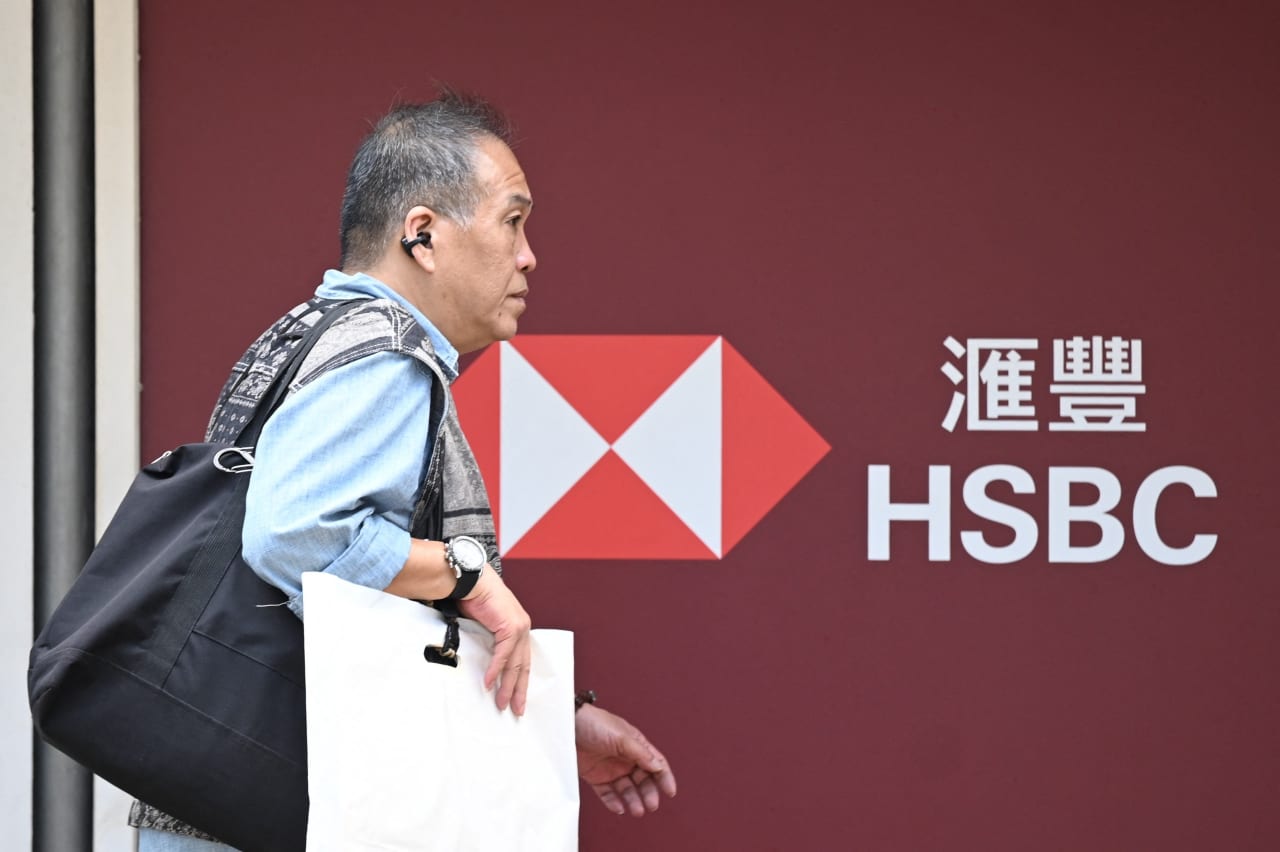Japan Trip Report (Plus Japanese Stocks)

Since the start of COVID, I had a frequent flyer mile award on China Airlines (TPE: 2610) that kept being extended until last summer when I was finally forced to make a booking as it was about to expire (a problem that has likely fuelled a good amount of recent travel…).
I have always wanted to see Kyoto (for the temple gardens, etc.). However, I could not get a redemption seat for the Taipei-Osaka leg (as the fall foliage season is a popular time to visit Japan). I was forced to fly KL-Taipei-Tokyo – with around 14 to 18 hour overnight layovers in Taiwan as using FF mile awards can be a real hassle!
This post is organized as follows:
-
Some Travel Market and Japan Observations
-
Expiring airline miles and/or awards seems to be a common problem (and is probably fuelling current travel).
-
Foreign (Instagram…) tourists not on organized packaged tours have hectic travel schedules as many do a considerable amount of moving around.
-
The dramatic increase in Japan Railway Passes and on some high-speed train routes will impact the Japanese travel market and potentially Japanese rail stocks themselves.
-
Cash is still readily accepted in Japan, but be careful using foreign cards while I am clueless about using app and IC card or app payment methods.
-
Japan is expensive, but not as expensive as I thought (plus Japanese convenience store RTE is practically gourmet with an endless selection).
-
Despite all the negative talk, department stores still seem to be alive in Japan – especially their food halls.
-
There were not many PRC tourists visiting Japan.
-
-
Japan Travel Resources
-
Two Potentially Useful Japanese Gift or Souvenir Ideas
-
Recent Japan Investing Research
-
Japanese Stocks You Might Encounter on a Trip to Japan
-
Japanese Alcohol, Beverage & Food Stocks
-
Japanese Airline & Airport Stocks
-
Japanese Hotel & Tourism Stocks
-
Japanese Railway Stocks (Note: Many are keiretsu type conglomerates that own hotels, entertainment facilities, retail, do property development, etc.)
-
Japanese Restaurant Stocks
-
Japanese Retail Stocks
-
Here are some travel market and Japan related observations for investors along with anyone thinking of visiting the country for the first time:
Expiring airline miles and/or awards seems to be a common problem (and is probably fuelling current travel). I have heard or read commentators talk about “revenge travel” in the wake of COVID. However, I overheard someone on one of my flights saying they were worried about loosing their FF miles “status” on the airline as they have not been doing as much business or leisure travel since COVID.
I suspect a good chunk of current airline travel is coming from people like me (and him) who need to use FF awards and miles that kept getting extended because of COVID. Once these awards and miles are used up, I have to wonder how many people will be traveling given many countries are still suffering from high inflation and have poor economies. Furthermore, many businesses (even in Asia where face-to-face is still important) have figured out how to conduct business with less need for travel (or they are doing more cost cutting…).
Foreign (Instagram…) tourists not on organized packaged tours have hectic travel schedules as many do a considerable amount of moving around. In Kyoto, I stayed for two weeks in a popular hostel who’s common room was a bit on the social side where I overheard many travel discussions.
I was surprised by the amount of moving around other tourists not on organized package tours do. For example: There was a couple from Chicago who said they had flown to Hong Kong where they visited Hong Kong Disneyland (WHY?!!! 🤷), then flew to Japan, and were going next to Korea. Granted, I overheard the husband say that his wife only gets two weeks off work a year while he gets more or could save up vacation days to take all at once.
I also overheard more than a few travellers say they did day trips from Kyoto to Hiroshima! When I look at Google Maps, I now see it’s doable on highspeed Shinkansen trains and you would get your money’s worth out of a rail pass:

But with this amount of travel, these tourists will be spending most of their time packing and unpacking and in airports/train stations/accommodations, in between airports/train stations/accommodations, getting to and from airports/train stations/accommodations, etc. with just enough time to hit the main tourist trap sights (Kyoto’s Bamboo Forest, etc.) to take the necessary Instagram shots and selfies. Then they will go back home and brag about seeing Japan or Asia… Without having seen much of Japan or Asia…
This sort of hectic Instagram travel by those not on organized packaged tours has implications for investors in tourism and travel related stocks as it means more money getting spent on airlines, trains, buses, taxis, etc. (rather than at actual tourist sites, etc.).
The dramatic increase in Japan Railway Passes and on some high-speed train routes will impact the Japanese travel market and potentially Japanese rail stocks themselves. After decades without a significant increase, the price of the Japan Railway Pass jumped by as much as 65% (or more depending on the media source) at the start of October (Here are the new prices for all JR rail passes after the October 1 price increase). The Japan Railways Group also revised prices for other passes on JR Hokkaido, JR East, JR Central, JR West and JR Kyushu trains.
When I was planning my trip, the Japan Travel, Friendly Discussion Group and other Facebook groups were full of posts from travellers asking if a Japan Railway Pass would make sense for their travel plans. I am not sure how many tourists take the time to calculate all their costs out, but it seemed like for many travellers who post on that group that the Pass makes no financial sense for their travel plans.
The alternative to the Shinkansen and slower speed trains are buses. There are many bus company options in Japan (I think some are actually owned by the railway conglomerates) and they are significantly cheaper travel options compared to high-speed trains. However, they take significantly longer e.g. a bus on the Tokyo-Kyoto route would either be an all night bus (which would help backpackers and other budget travellers save money on accommodations) or an all day bus (and waste a day that could otherwise be used for sightseeing).
It would also take more time for foreign tourists to figure out where to go and what to do to catch a bus (versus just going to a major train station in the middle of the city with a ticket or tourism office where someone speaks English…). But I suspect the other train price increases will help the bus companies gain more business from locals who won’t have the same problems foreign tourists would have when trying to use them. Likewise, foreign Instagram tourists might be encouraged to have less hectic travel schedules and do less moving around.
I ended up paying ¥14,170 or around $94 (at ¥150 to US$1) one way at train stations with my credit card for 11AM Monday Shinkansen trains between the two cities (roughly 2 hours and booked a few days before I travelled).
Cash is still readily accepted in Japan, but be careful using foreign cards while I am clueless about using app and IC card or app payment methods. I wanted to have my train bookings taken care of before going to Japan as I had just received a new credit card (I only have one which I rarely use) and needed to make sure it worked as I don’t use payment apps.
The Smart-ex.jp online railway booking site quoted me something like ¥11,000 or around US$80 (travel platform Klook, who is rumored to be preparing an IPO, wanted $100+ without the ability to pick a seat) for a Tokyo-Kyoto ticket, but would not take my foreign Visa card (apparently, they cancelled the contract with Visa some years ago, but take Amex). Not only that, I got slapped with a HOLD on my card and had to call my bank in the USA; but had no problems when using the card at train stations and two shops…
Likewise, cash is still readily accepted and self-checkout cash registers or the staffed machines at convenience stores and supermarkets are fairly easy for foreigners to use with the friendly staff always being helpful:
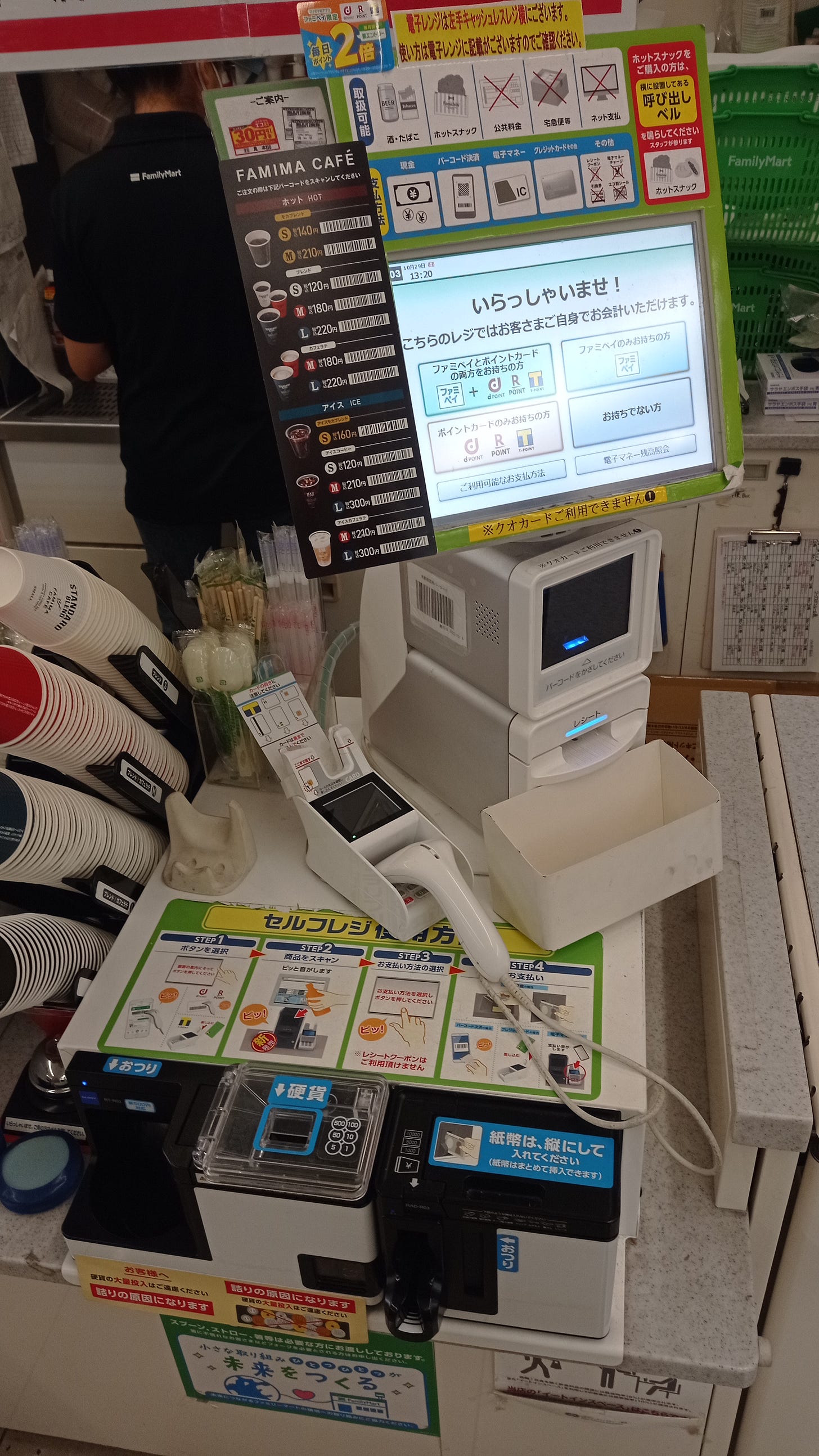
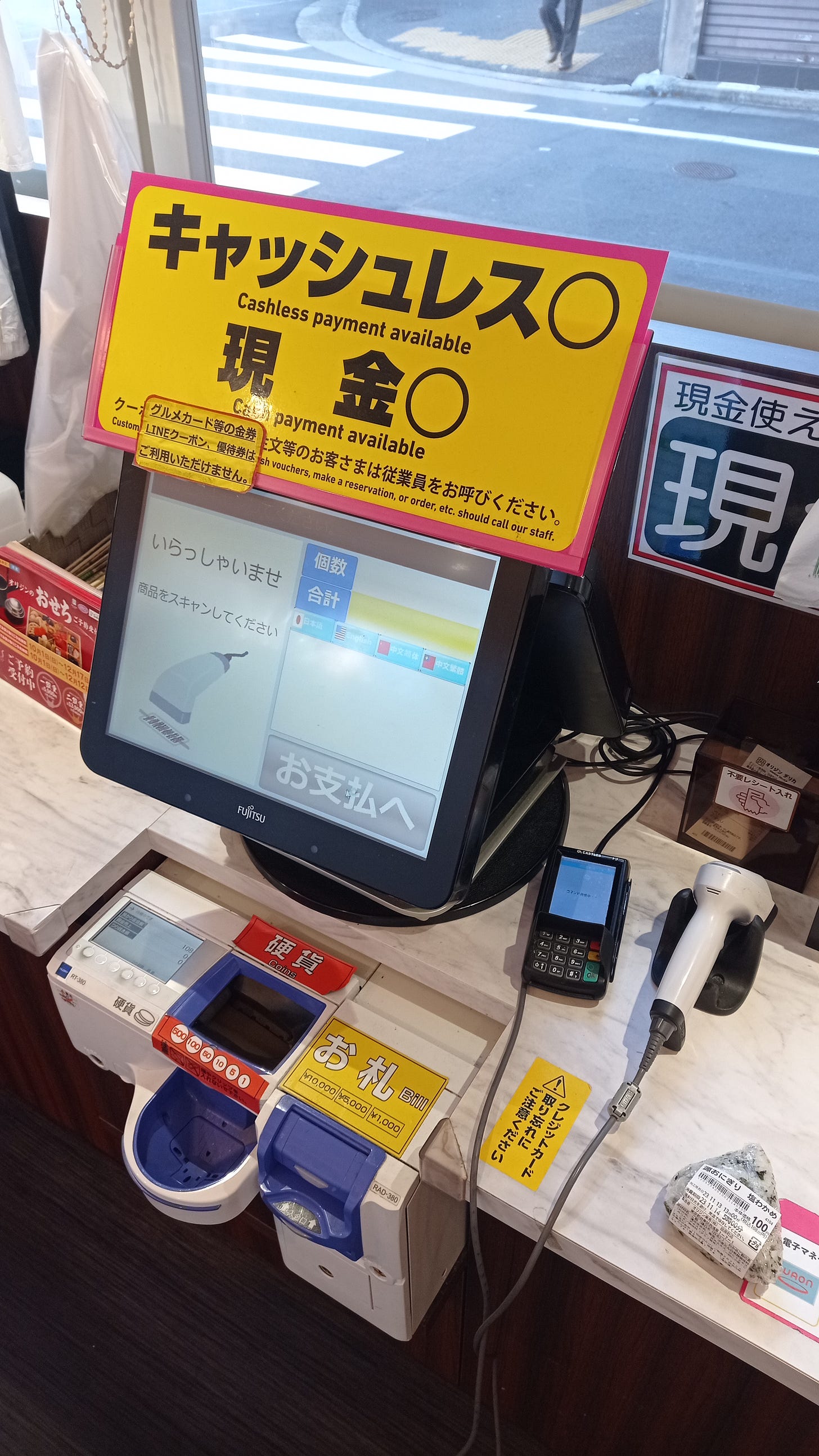
I had no trouble paying (coins) during the day at the same “unstaffed” (at least nobody working the cash machine) Origin Delica shop that is the subject of this article where the writer ran into problems:
Chaos at unstaffed Japanese bento shop shows pitfalls of technology (Japan Today) November 2023
Those looking for a Japanese bento or side dish can stop by a well-known chain called Origin Delica, which has an unstaffed store in Tokyo’s Nishi-Asakusa district. Our reporter Seiji Nakazawa, who’d never visited an unmanned store before, popped in one evening to try it out, and when he stepped inside, he couldn’t quite believe that it was unsupervised, albeit with staff hidden out the back, who can be called on if help is needed.
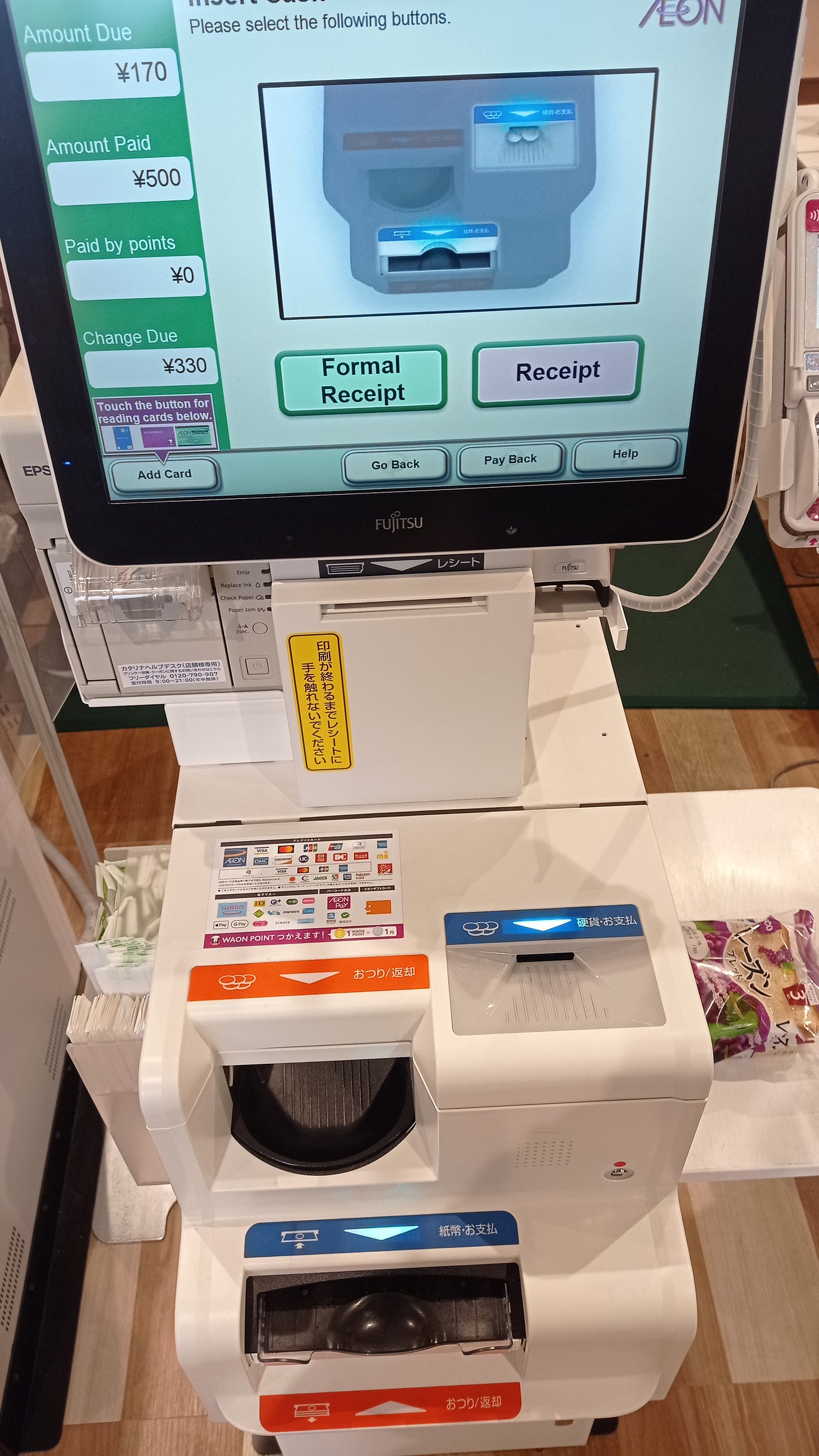
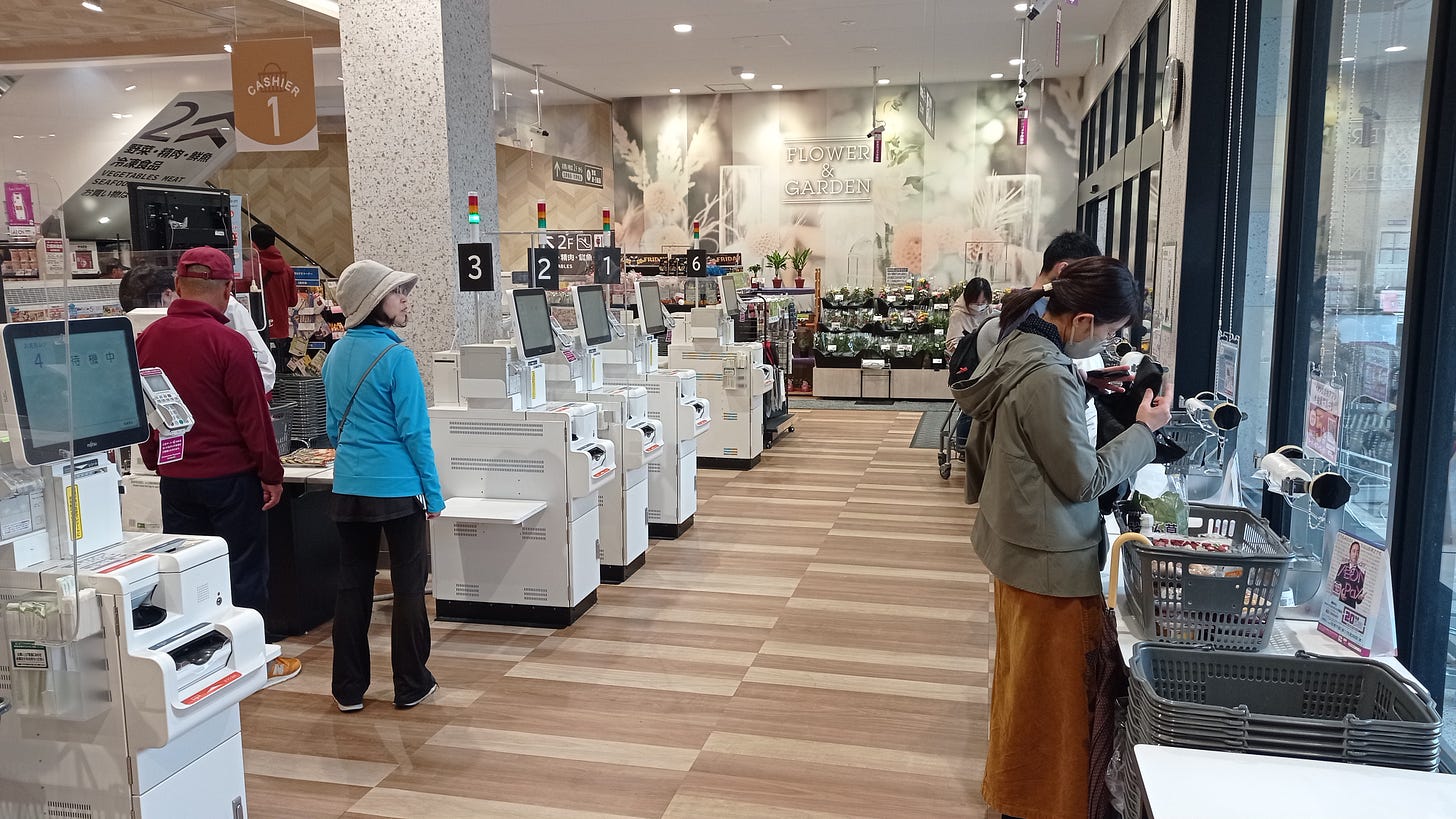
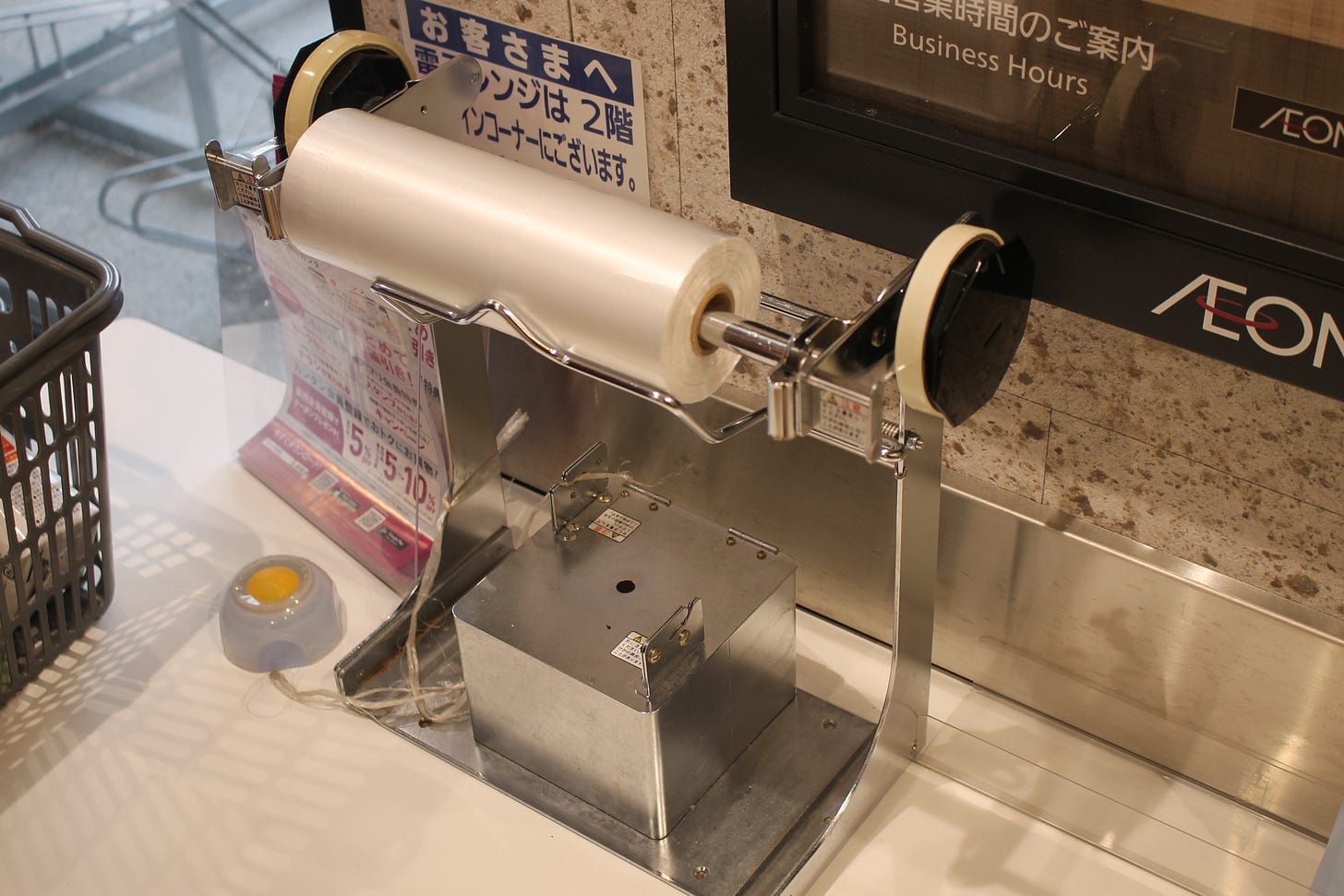
If anyone knows what companies, especially if they are publicly listed, who might be the makers of such machines, please indicate them in a comment:
There are posts on the Japan Travel, Friendly Discussion Group concerning various apps and some sort of IC card used in Japan for payments. But again, I don’t use such apps – so can’t shed any light about them.
Japan is expensive, but not as expensive as I thought (plus Japanese convenience store RTE is practically gourmet with an endless selection). Since I was travelling alone, I stayed at hostels or guest houses. The days of backpacking around Asia and spending a couple of dollars on a bunk in a guest house are long gone. Today, you are probably looking at spending US$10-30+ a night for a bunk or capsule in a decent hostel (one with good reviews and amenities) in major Asian cities.
I did get an extra good deal on Agoda for 3 nights (including the weekend) and 2 more (mid week) at the Guest House Tokyo Samurai in the convenient Asakusa area (where there are many budget accommodations plus a train to Narita) for around $95 total or $19 a night:
A two week stay booked at K’s House Kyoto (a short walk from the main train station and subway lines) came to around $280 total or $20 a night when booked on Agoda, but I also had to pay them an additional tax in cash when I got there (so it was probably around $22-23 a night):
While I don’t recall if guest house in Tokyo had private rooms, the second place did have private rooms a family or group could rent for themselves (albeit I think the bathroom facilities would still need to be shared). Having a kitchen with a microwave and refrigerator plus laundry facilities (and plenty of English speakers around definitely makes life easier for first time visitors to Japan.
As for eating in Japan, that was another concern of mine. In Malaysia, you can get a decent meal (local sized portions) for RM10-12+ or US$2-2.5+ without a drink (unless there is a lunch special) at local restaurants and mamak places. Let’s just say it can be more expensive to eat in Japan for someone coming from or accustomed to SE Asia prices.
But the Yen was ¥150 to US$1 when I was there (and I was using dollars). At that rate, Japan is probably a wash for someone coming from North America or Europe (and accustomed to their restaurant prices) – except when it comes to buying fresh fruits and vegetables along with imported products like Muesli (TRAVEL TIP: I should have brought some extra bags of Muesli from Malaysia, aside from a partially finished one, to eat for breakfast as the suitcase space could then be used for souvenirs while good quality imported Muesli is even more expensive and harder to find in Japan…).
In Malaysia, supermarkets have been selling Japanese created Shine Muscat grapes grown in China (apparently, the Japanese did not properly register the grapes and the Koreans and Chinese started growing them) claiming they are “as sweet as honey.” I was sceptical, but bought a container when they were on sale for RM8.89 or US$2:
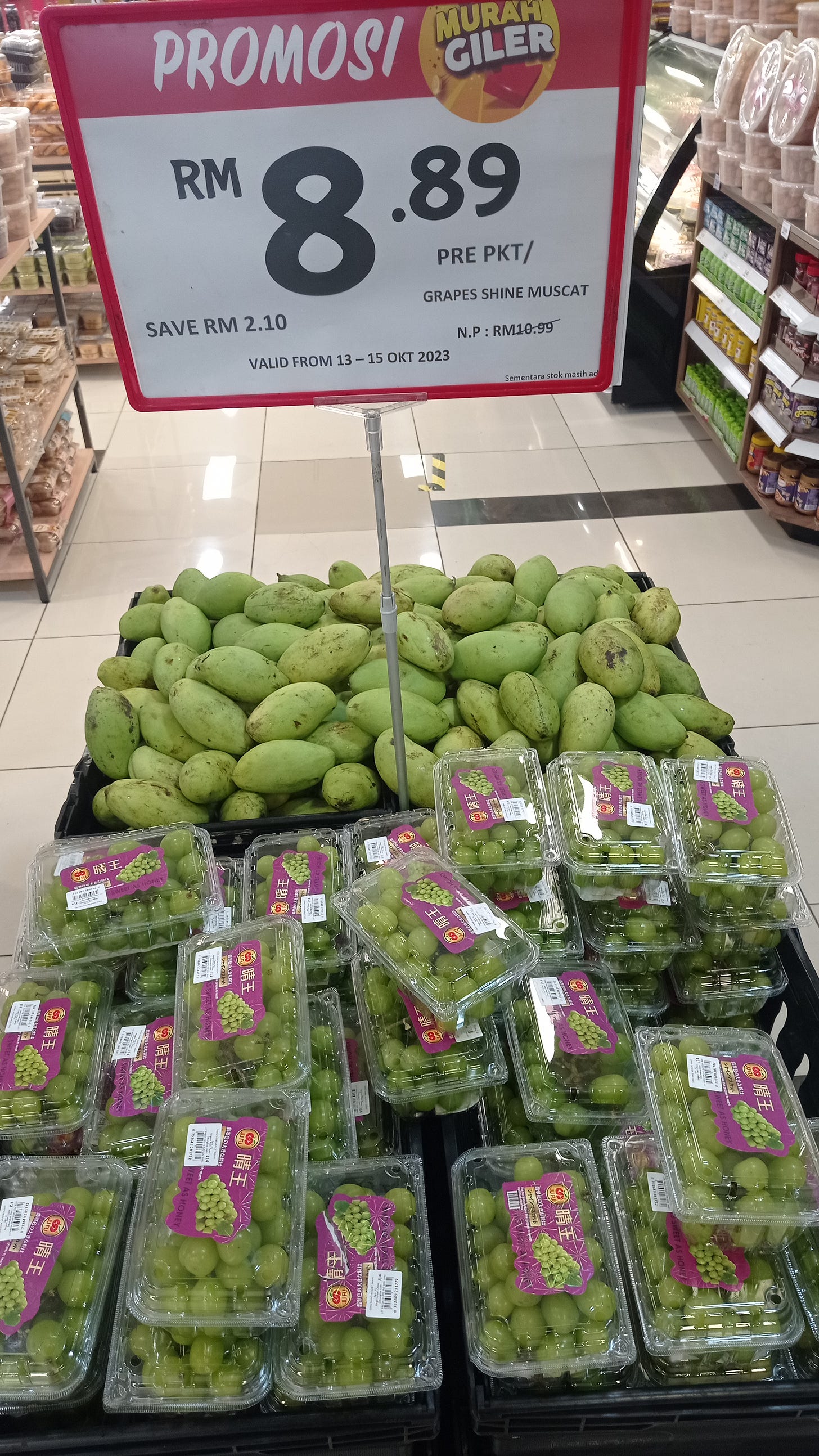

They are as sweet as honey (no tartness like with traditional grapes) and are absolutely delicious.
In Japan though, Japanese grown Shine Muscat grapes sell for considerably more than RM8.89 or US$2:

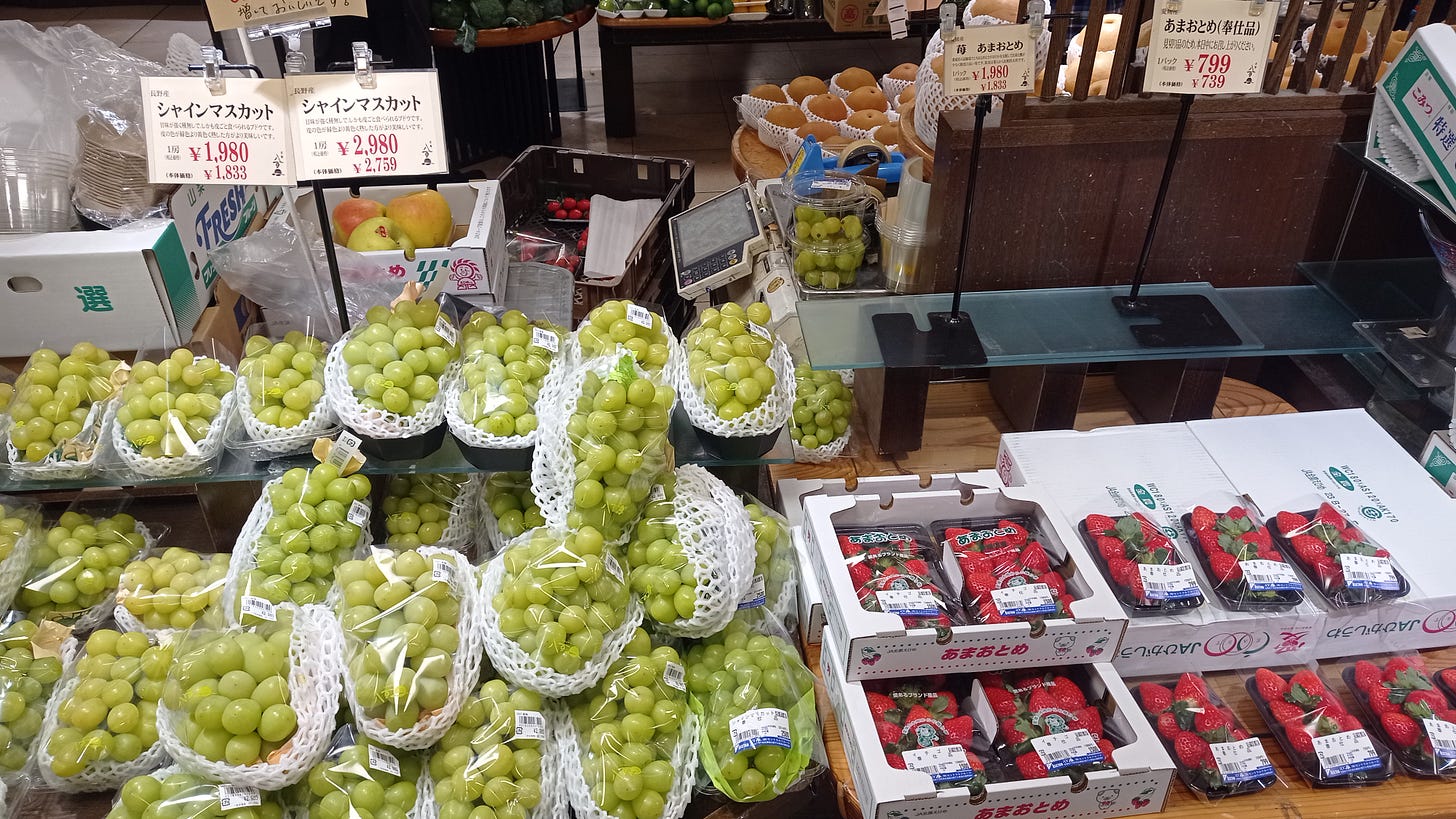

Although this Muscat juice was reasonably priced (and rather tasty):
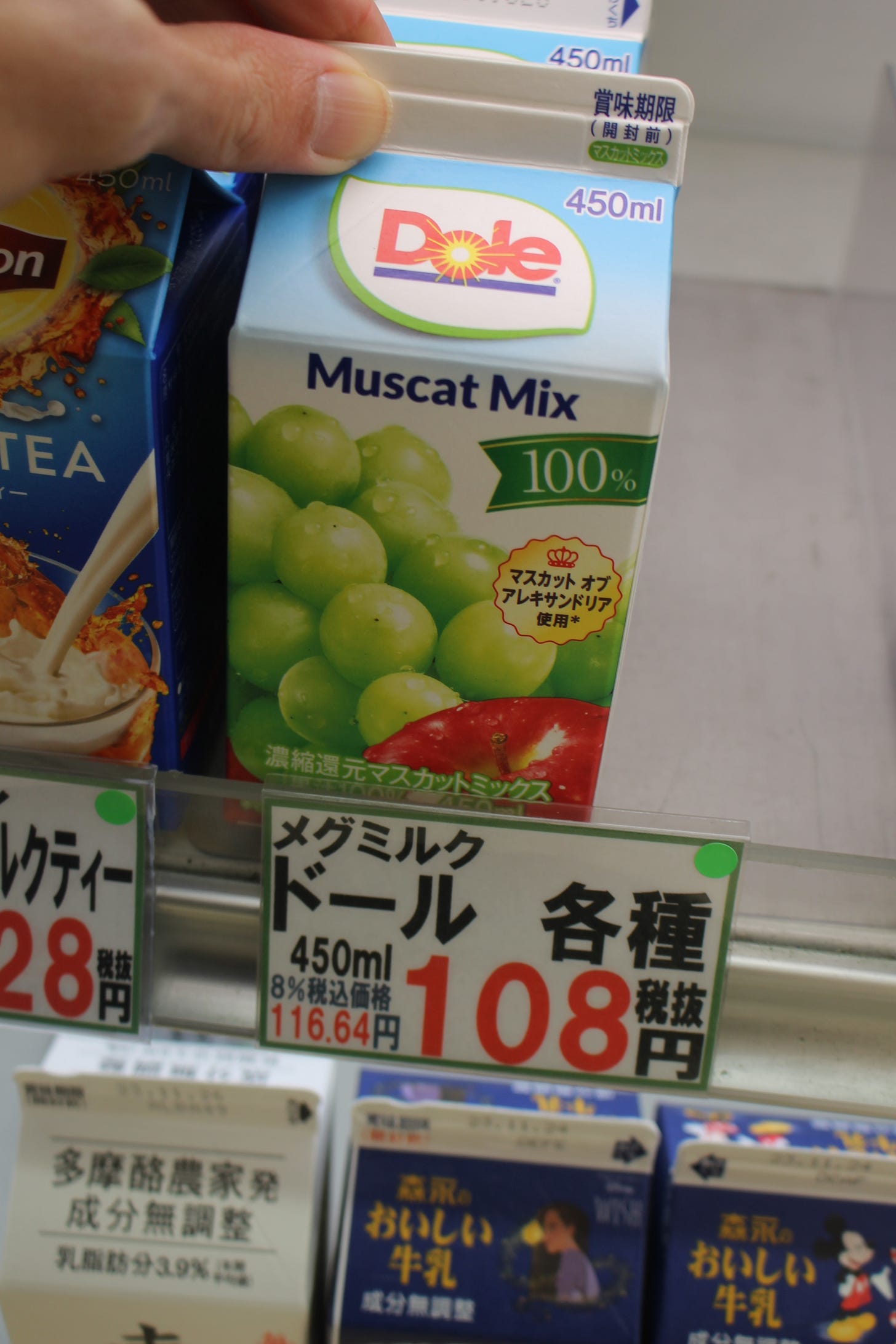
I ended up eating mostly convenience store food as, well, it was convenient (I could work on the computer and just put dinner in a hostel refrigerator to heat up later to avoid going out in the cold to look for something to eat) and practically gourmet. For example: This butter chicken curry for ¥399 or US$2.70 from 7-Eleven was absolutely delicious:
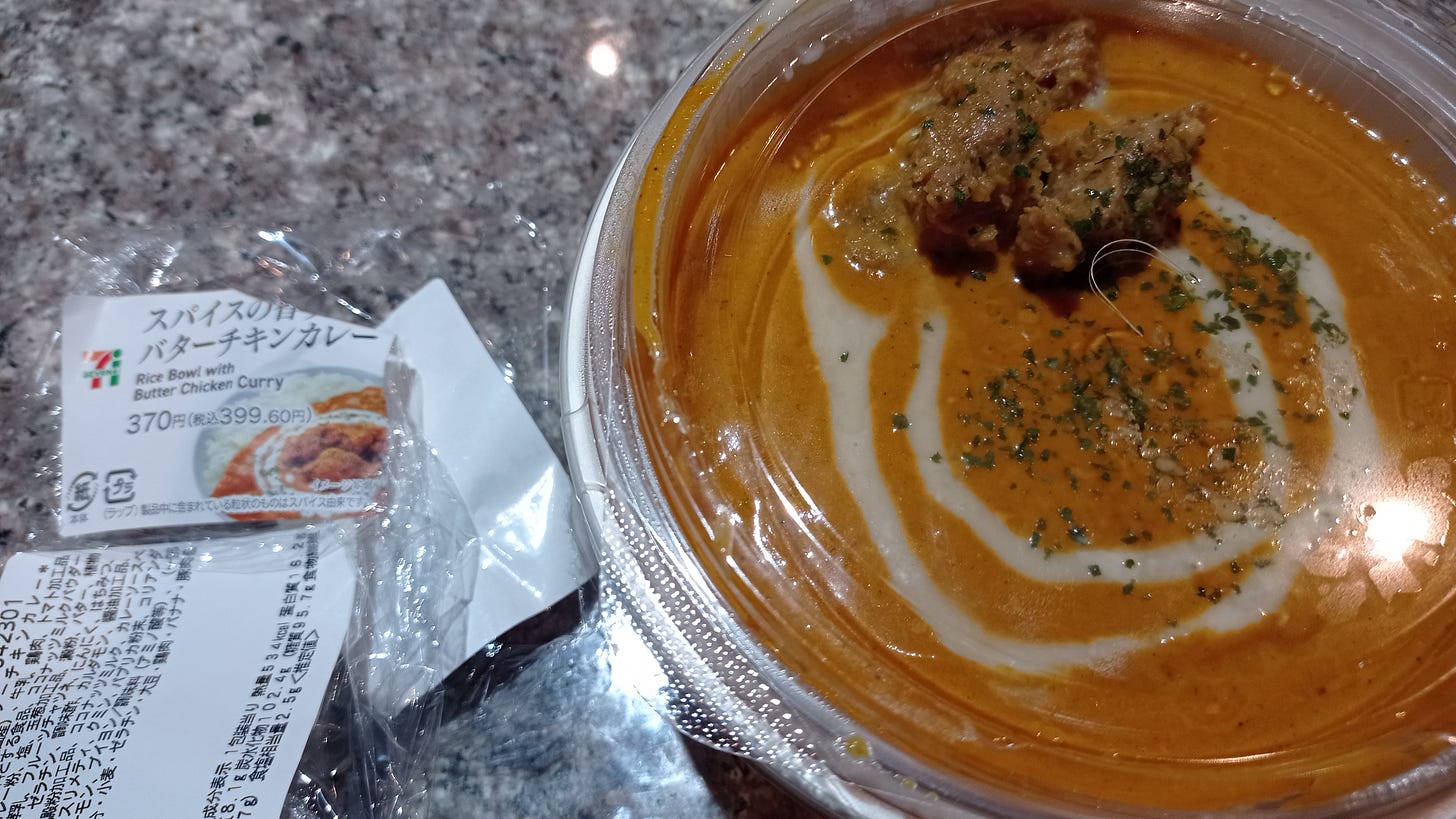
You can never go wrong with Japanese curry – even bought from a convenience store:
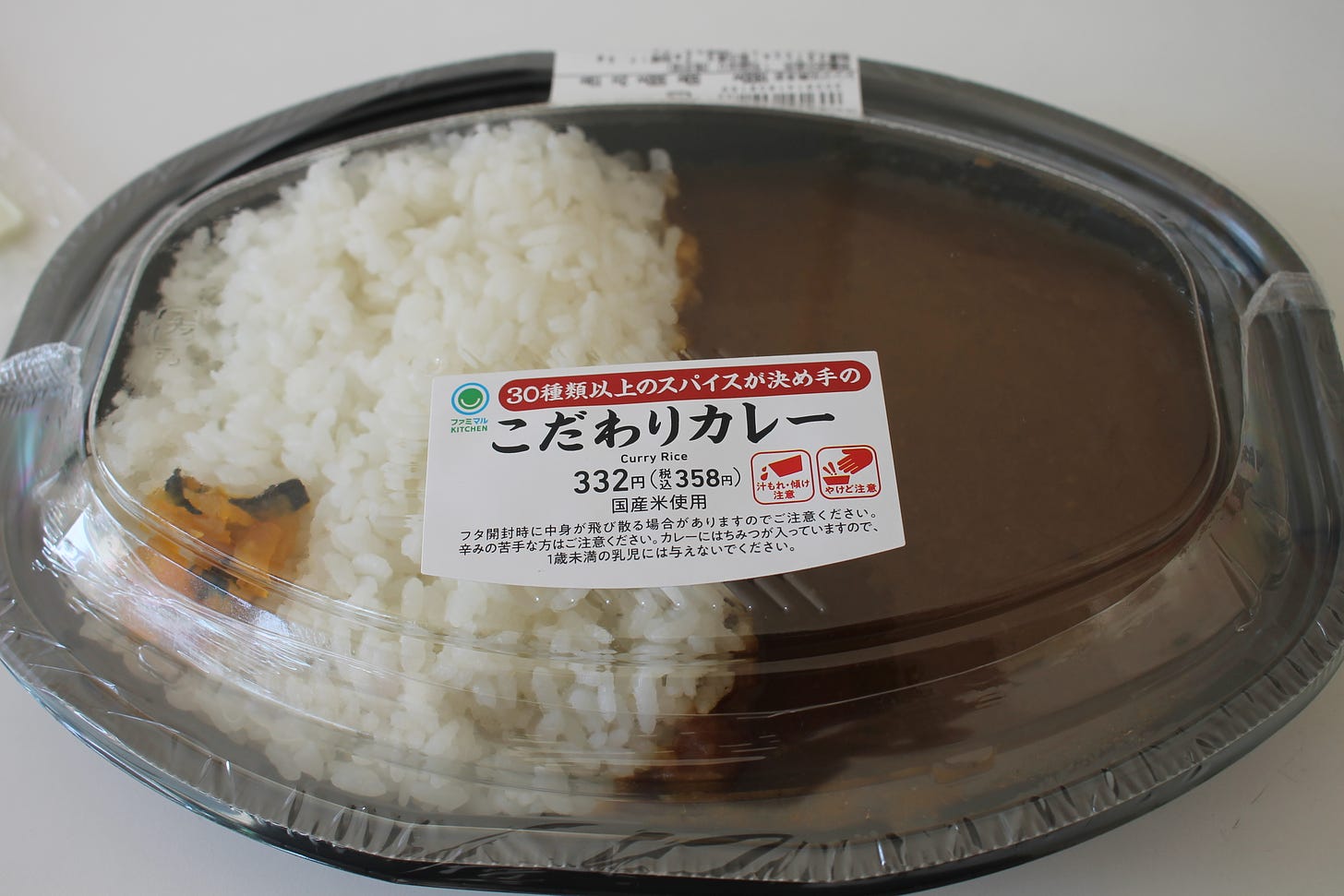
They even have microwavable gyoza:

And Okonomiyaki (Japanese savory pancake):
These cup of Miso soups also hit the spot when walking around on cold days:

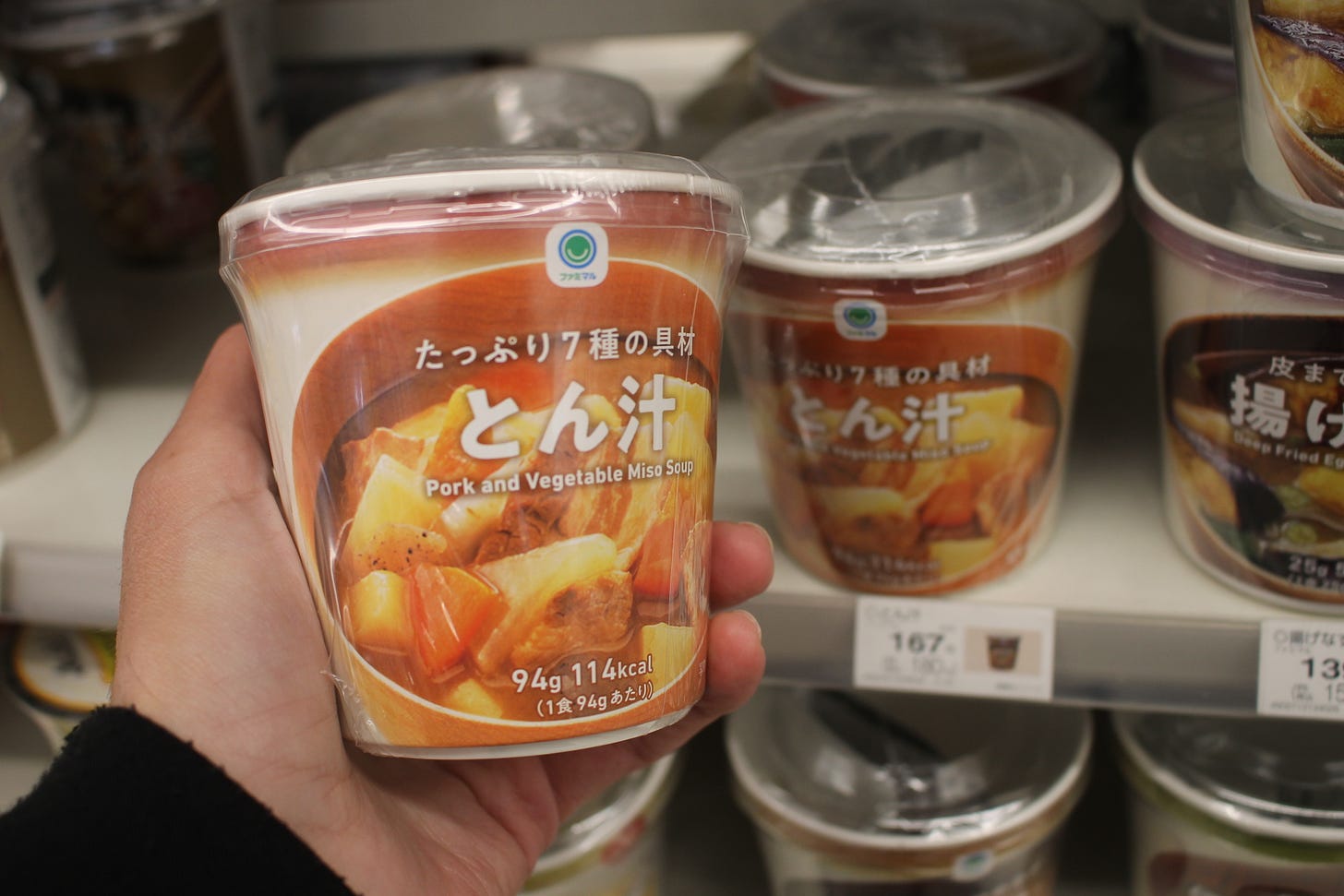
These salad cups are small, but again, practically gourmet:

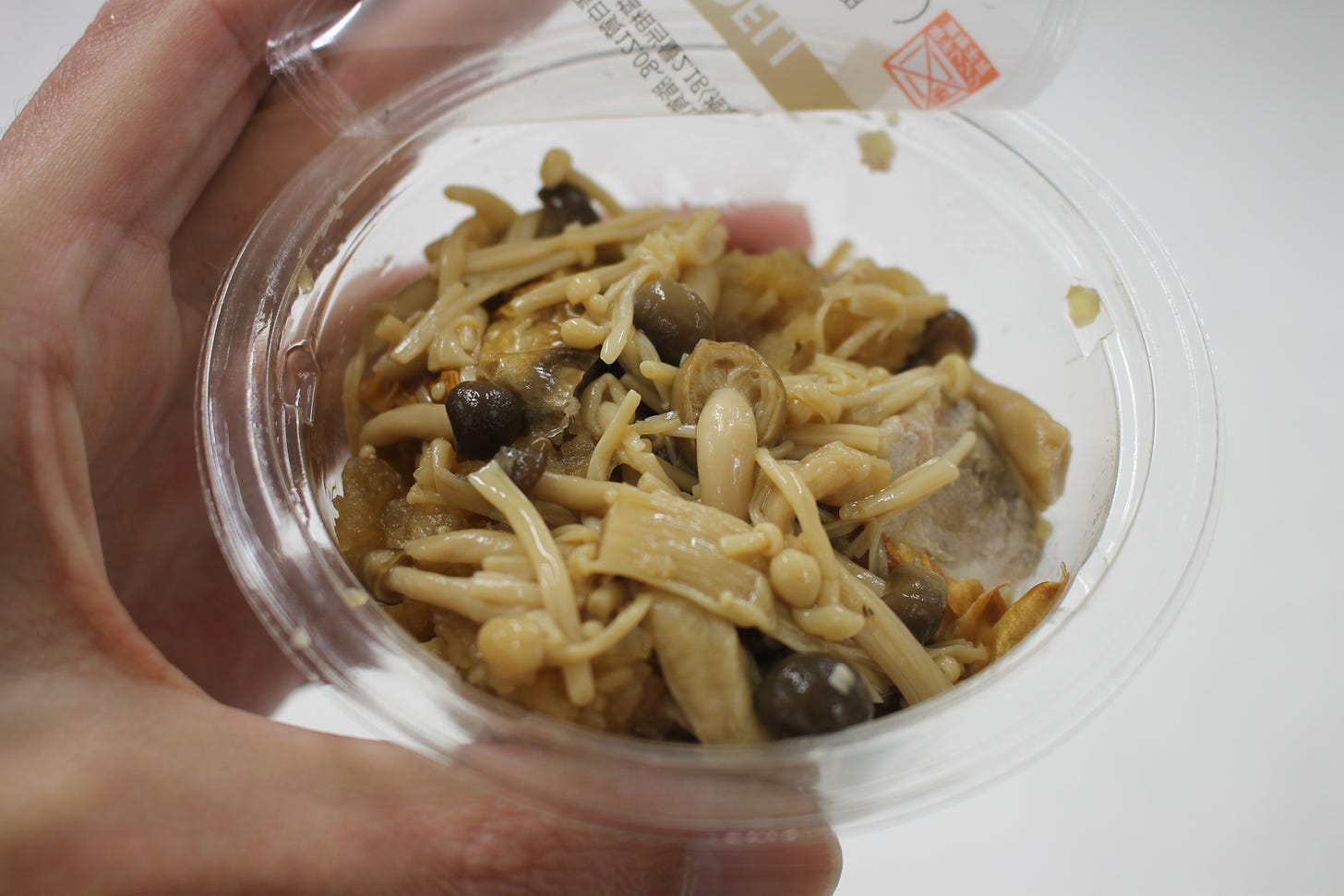
You could probably spend months in Japan eating at various convenience stores or the RTE sections of supermarkets and NOT eat the same thing twice as the selection seems almost endless:
And its a good thing there are so many convenience stores with good food because many small Japanese restaurants don’t want to deal with you if you don’t speak Japanese – and they are not afraid to tell you either!:
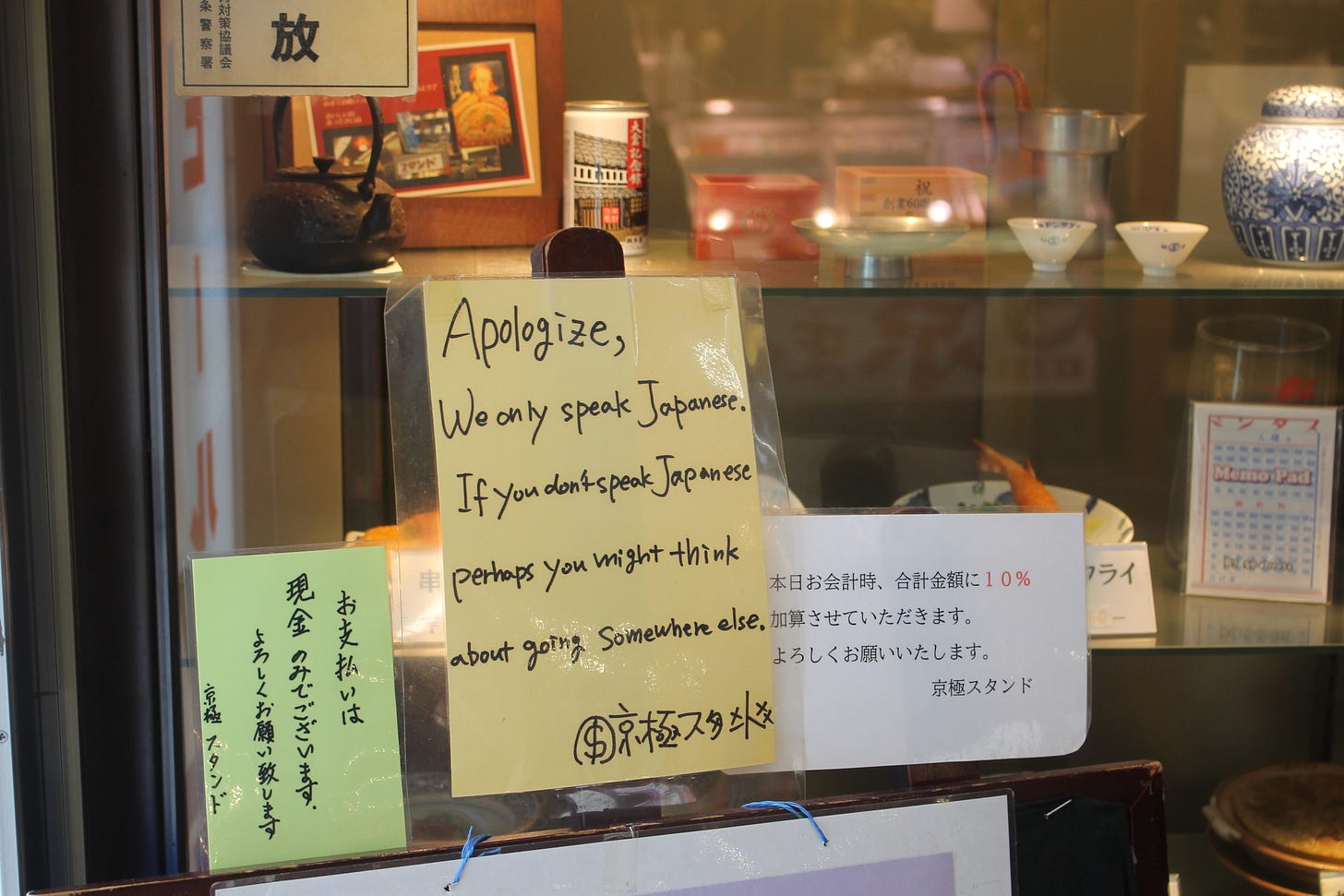
The only problem was the lack of a seated eating area in smaller city convenience stores for eating a heated lunch (plus eating on the street is frowned upon in Japan). However, getting sushi or some sort of wrap for lunch made things easier and could be quickly eaten while on the go (as it gets dark by 5PM in the fall plus everything closes by then – so you need to maximize your daylight hours for sightseeing).
Note that this Ayatka Cafe matcha coffee apparently made by Coca-Cola Bottlers Japan Holdings (TYO: 2579 / FRA: CCW / OTCMKTS: CCOJY) is addictive, but not always easy to find (I think only certain chains or outlets had it):
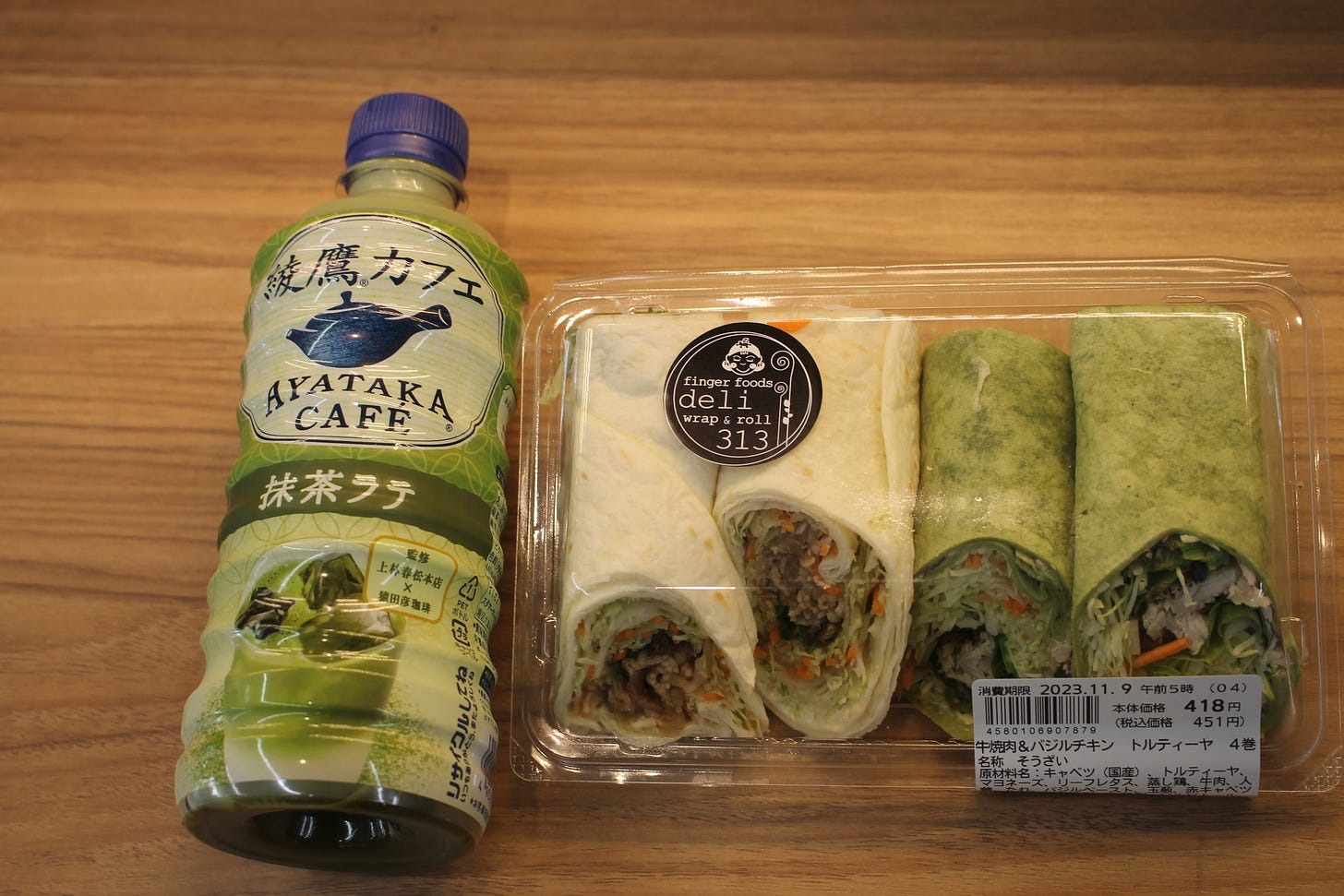
I was not in Japan long enough to be able to distinguish a major difference in strategy between the big convenience store operators Lawson (Lawson Inc (TYO: 2651 / FRA: LAW / OTCMKTS: LWSOF)), Ministop (Aeon Co Ltd (TYO: 8267 / FRA: JUS1 / OTCMKTS: AONNF)), 7-Eleven (Seven & I Holdings Co Ltd (TYO: 3382 / FRA: S6M / OTCMKTS: SVNDF)) and FamilyMart (Itochu Corporation (TYO: 8001 / FRA: IOC / OTCMKTS: ITOCF)).
I did not see or go into as many Ministops (there were many in the Philippines when I lived there in the early 2000s), but it seemed like they were slightly more geared towards locals as some of the RTE items were not in English (whereas you could at least figure out what you were eating at the other convenience stores).
In addition, the Daily Yamazaki convenience store chain owned by baking behemoth Yamazaki Baking (TYO: 2212 / OTCMKTS: YZZKF / YMZBY) also seemed to be geared towards local Japanese. Or rather, they seemed to be in local neighbourhoods rather than tourist areas.
One thing I can comment on: The convenience stores in Japan clearly have a price and convenience advantage with little competition (except with each other). In Malaysia and elsewhere in SE Asia, 7-Eleven and FamilyMart would be competing with street food, mamak stands, night markets and now Korean convenience store chains.
FamilyMart entered the Malaysian market a few years ago and I would sometimes get their RTE during the COVID lockdowns (plus ordering and waiting for made to order food at a mamak can take forever while their already prepared food is not always the most hygenic). Their RTE is good, but not as good as in Taiwan or Japan) and their last price increases were out of hand – I don’t see how they can stay competitive (on price) with all the other eating options available beyond the food safety standpoint (some locations in my city center neighbourhood have also closed).
In addition, Korean convenience stores have entered the Malaysian market offering spicier or more interesting options which appeal to locals and myself included. In Japan though, the Korean convenience store chains don’t appear to have a presence.
Despite all the negative talk, department stores still seem to be alive in Japan – especially their food halls. There is no doubt that traditional department stores are in serious trouble in the USA and many are not doing well in SE Asia as well. This recent article outlined the troubles they face in Japan:
📰 The demise of the Japanese department store (Nikkei Asia) June 2023
Today there are 185 surviving department stores, compared with 55,000 convenience stores and 19,000 supermarkets. In 2022, Fast Retailing Co Ltd (TYO: 9983 / FRA: FR70 / FR7 / OTCMKTS: FRCOY / FRCOF), the parent of the fast fashion brands Uniqlo and GU, sold more apparel in Japan than all the department stores combined.
A radical shift in demand starting in the 1990s toward cheap, disposable, casual clothing blindsided the department stores. A similar damaging shift took place in the market for home furnishings, typically located on the floors above apparel.
Fish, meat, vegetable, fruit, tofu, sweets and hardware stores in shotengai (local shopping streets) met a similar fate as convenience stores and supermarket chains, suburban malls and superstores siphoned off business.
Another blow came when Japanese began to ignore their ancient seasonal gift-giving obligations. Department stores used to rely on the summer (chugen) and year-end (seibo) gift-giving seasons for a substantial portion of their revenues. Today, seasonal gift-giving has become optional, a data point in the changing soul of Japan. The arrival of Amazon in Japan in 2000 and the iPhone in 2008 were further body blows.
However, the department stores I went into in the Ginza district plus Kyoto shopping areas seemed to be doing alright as they were crowded – especially their basement food halls:
As you can see from the pictures above, the quality and diversity of the food available in Japanese department store food halls is second to none and people were buying it. I suspect the remaining department stores have a chance of surviving (at least in major cities that also have many foreign tourists) as the Japanese clearly appreciate quality products and are willing to pay for them.
I think the same can be said of the many remaining small restaurants (places that look like they could only seat a dozen people with the chef owner cooking behind the counter), shops, etc.
There were not many PRC tourists visiting Japan. There seemed to be many tourists in Japan from all over – plenty of Americans and Europeans, including people from France, Italy, Spain, Northern Europe, and even Russia (e.g. there was a small tour group on the Tokyo subway with the guide holding a Russian flag, plus I heard what sounded like Russian spoken elsewhere), Latin America or Mexico (I was surprised that the Imperial Palace in Tokyo even had French and Spanish speaking tour guides), etc.
I also encountered Malaysian, Indonesian, Korean, and Thai tourists along with an assortment of Overseas Chinese (Singapore, Taiwan, etc.) BUT hardly any PRC tourists.
At one popular temple that I twice walked by in Kyoto, there were bus loads of tourists who might have been PRC Chinese on packaged tours. Its usually easy to identify PRC tourists on package tours (by how they are dressed) in Asia as I think they tend to be from secondary, etc. Chinese cities whereas those from big international cities like Shanghai and Shenzhen more easily blend in with other Overseas Chinese (plus they can probably afford to travel independently of package tours).
Statistics (from when I visited) also show Chinese tourist arrivals in Japan have cratered compared to pre-COVID days:
Aside from the fact that Japan has a reputation for being expensive and might not be affordable for many PRC tourists, I assume its still difficult for them to travel overseas (especially independent of packaged tours and to USA aligned countries like Japan…) even though Beijing did lift the ban on group tours on August 10th.
However, Beijing also imposed total ban on Japanese seafood on August 24th – the same day Tokyo Electric Power Company Holdings (TYO: 9501 / FRA: TPO / OTCMKTS: TKECF / TKECY) began discharging treated radioactive water into the ocean from the grounds of its Fukushima No. 1 nuclear power plant.
That did not stop the region of Fukushima from having this booth at a weekend food fair in front of Tokyo’s main train station when I was there in late October:
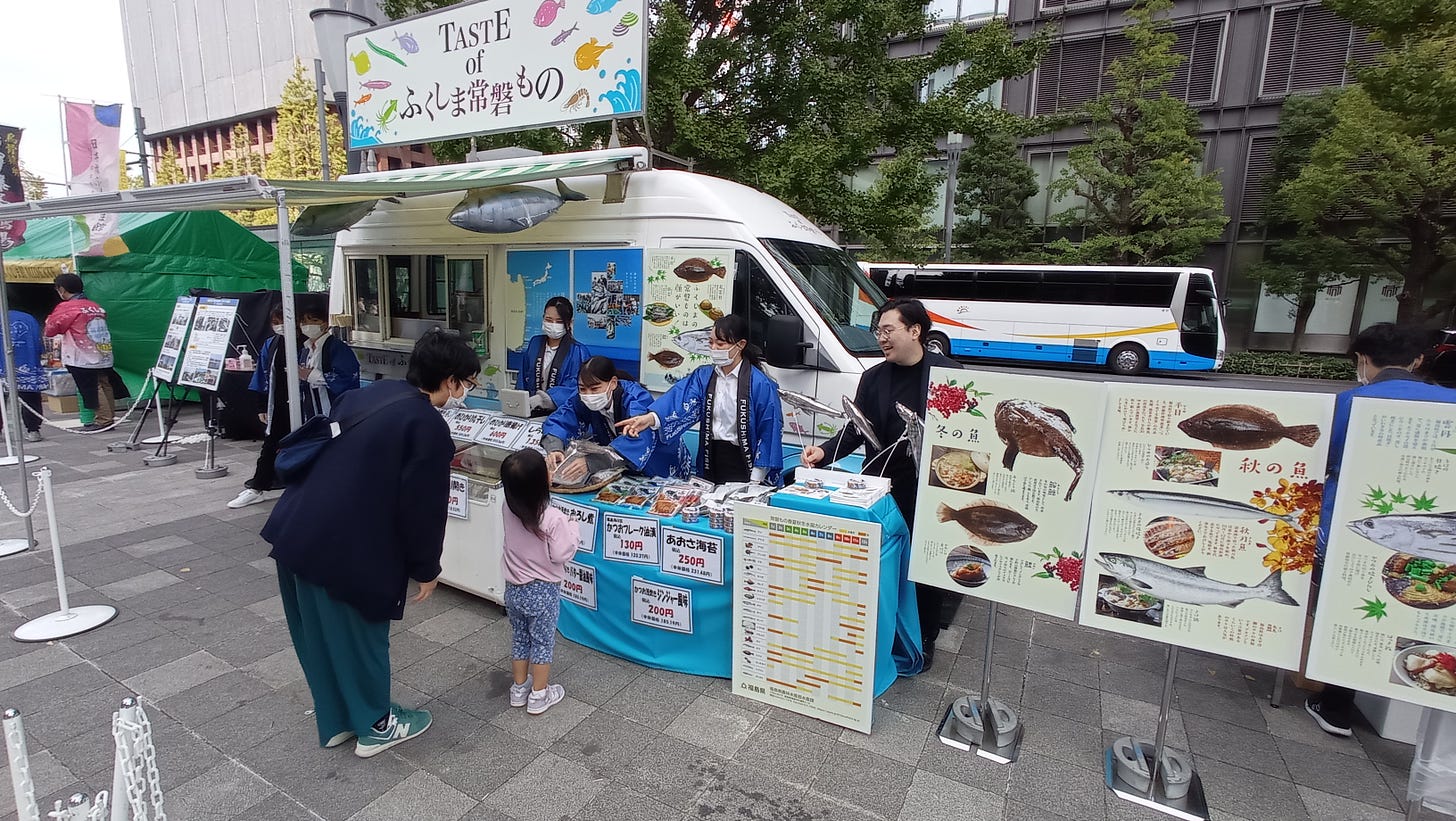
Needless to say, I gave the Fukushima fish a pass…
IF you have never been to Japan before, I suggest flying to Osaka, take a commuter train to Kyoto and avoid Tokyo. The latter is just a big huge city that will take an hour to get into after you arrive and more time to figure out how to get around once you are there. While you can spend months in Tokyo and not see or do all the usual big city activities, the more interesting or uniquely Japanese sights and activities would be in the Osaka-Kyoto region.
I spent two weeks in Kyoto and could have easily spent a month there and not have seen every temple or garden. I never got around to doing a day trip to Osaka, Nara (Japan’s ancient capital before Kyoto), Lake Biwa or taking the special trains to see foliage in the hills around Kyoto.
For Tokyo, the Asakusa district is very convenient to stay, has budget accommodations and the Asakusa train station has regular trains to Narita (50+ kilometres outside the city). And although the Tokyo subway map looks intimidating, it seemed like I ended up spending most of my time on one or two subway lines. For example: I could walk several minutes to Tawaramachi Station on the Ginza Line (which starts at Asakusa train station, goes through the Ginza district and ends at the Shibuya Scramble Crossing) and everything not on that line seemed like one transfer to another line away. And you only needed to buy one ticket with subway stations on different lines being connected (albeit with tunnels and lots of stairs – so not always friendly for disabled people).
The Kyoto subway and rail network was actually more confusing as I found out the rail lines have different operators, are not connected and don’t use the same tickets. For example: For some sites in one particular area, I had to leave the station and walk a couple of minutes (over the tracks) to another station where the train was a one car tram.


In addition, express trains to Osaka run on the same lines and platforms as local trains. I accidently got on one and ended up having to backtrack to the station at the Inari shrine on a local train that makes all stops.
For anyone planning to visit Japan and Tokyo and Kyoto in particular, I suggest joining, looking at, or posting questions on the following Facebook groups (Note: You can post questions on public Facebook groups without joining them):
Online reservations a few months in advance (especially for cherry blossom and fall foliage seasons) will likely be needed for places managed by the Imperial Household Agency (Registration Link) – all are worth seeing IF you have the time and are interested in Japanese gardens:
Be aware that the online reservation site shuts down for maintenance between Midnight-5AM Tokyo time at the start of every month so they can add the next month to the system. For the Imperial Palace in Tokyo, I woke up at 4AM (SE Asia time) at the start of the month to ensure a reservation for a morning tour for the only day (a Saturday) I had available in October (they send a confirmation email):
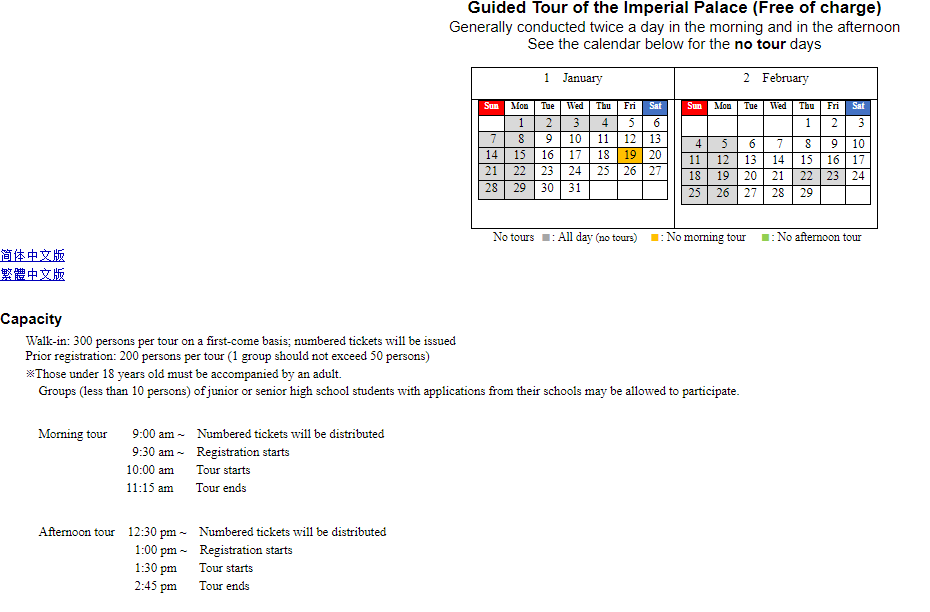
Spaces were already filled when I attempted to make an online reservation for the Shugakuin Imperial Villa on the outskirts of Kyoto. However, I was able to go to the Imperial Household Agency’s office (I had emailed and they told me to go to the office to make a reservation) at the Kyoto Imperial Palace and made a booking for my last day in Kyoto to avoid having to go there and hope they have spaces for those without reservations.
IF you are planning to visit Kyoto, I highly suggest: Kyoto, 29 Walks in Japan’s Ancient Capital: The Definitive Guide to Kyoto’s Temples, Shrines, Gardens and Palaces

There is so much to see in Kyoto and many worthwhile sights are spread out all over the city – meaning you will do a considerable amount of walking and will need to do some planning. The book divides the city into more manageable walks with easy to use maps and detailed descriptions and explanations of the historical significance of sights on each walking tour.
For example: This is Walking Tour 19 covering the area around the Bamboo Forest (more of a Instagram tourist trap…) and I had to spend two days in the area to see everything:
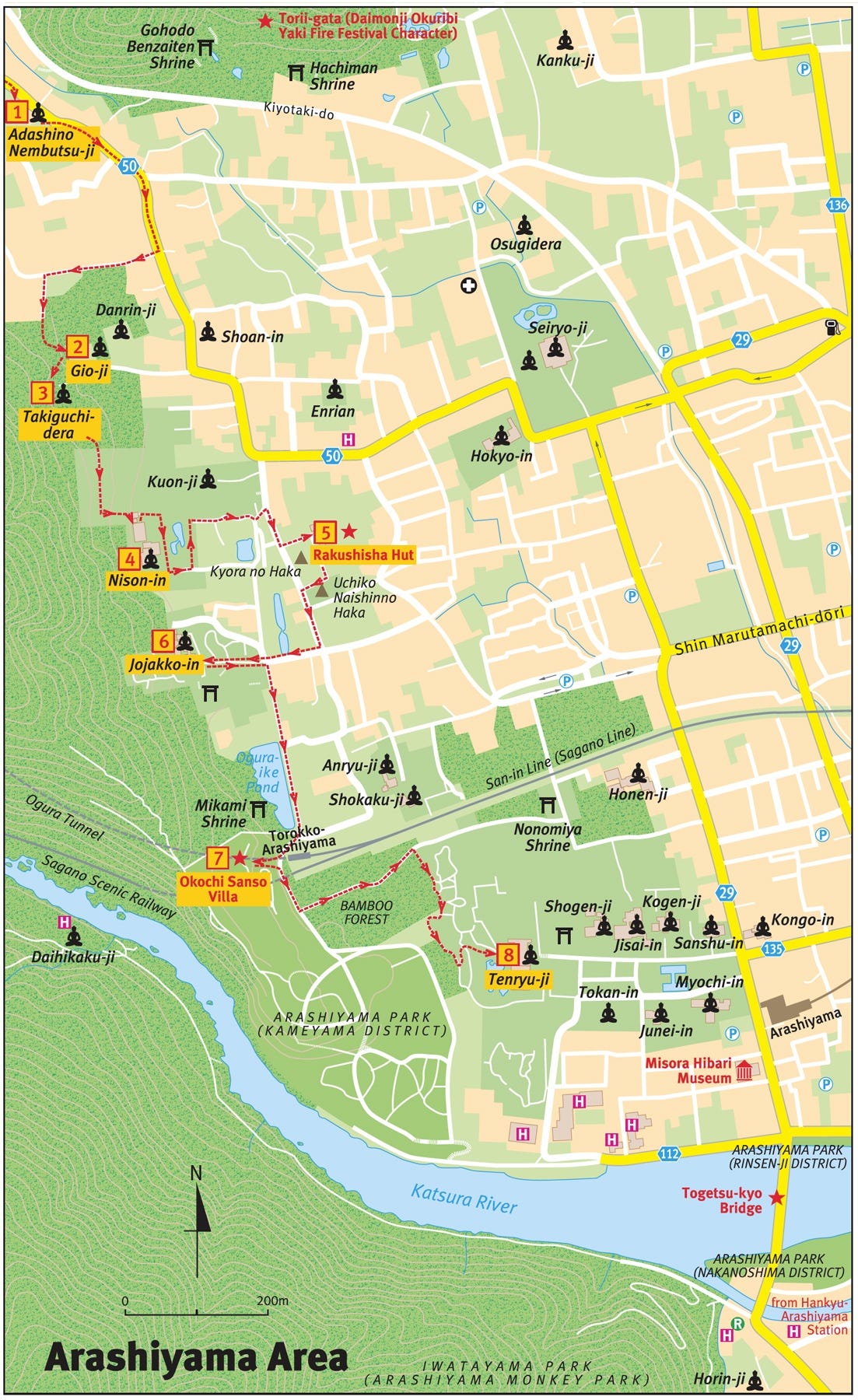
I then looked the places up on Google Maps for any URLs, pictures or reviews and added them with some notes to my travel itinerary in Word format to help me decide what sights were worth seeing (and spending 300-600+ Yen on) when in Kyoto:

Other Japan related travel books that I have on my computer and consulted:

I also searched HDclump for some Japan travel and cultural documentaries with the following multi-episode series from British TV being worth watching.
In addition, Expoza Travel on YouTube is one of the few YouTube channels with no nonsense destination videos. Their Japan travel guides can be found here.
Something to love about Japan is how small shops (some of which might be hundreds of years old) selling high quality goods with and personal expert service have somehow managed to survive in a world dominated by big box retailers and online shopping selling cheap disposable junk made in China.
When traveling, I do try to find some useful things to buy e.g. stuff that won’t just sit on a shelf to be looked at and collect dust. When I visited Taiwan’s Kinmen Island off the coast of Xiamen, I bought some Maestro Wu Bombshell Steel Knives direct from the factory that cut salami like its butter:
Japan also has knife shops where you can buy high quality knives:
I was also thinking of buying a pair of Japanese style garden shears (the ones in the box with a yellow background), but these are not cheap (I think they are primarily used for trimming Bonsai and pine trees):

On every trip to Yangon, I have bought high quality hand made marionettes from a particular downtown shop (Myanhouse Local Made) that I know are not made in China. I wanted to do the same in Japan, but got annoyed when I figured out the dolls there are all “Made in China” because one shop forgot to remove the sticker on the bottom (it will also say “Made in China” on the box) although I did buy a “Made in China” ninja doll just for the heck of it:
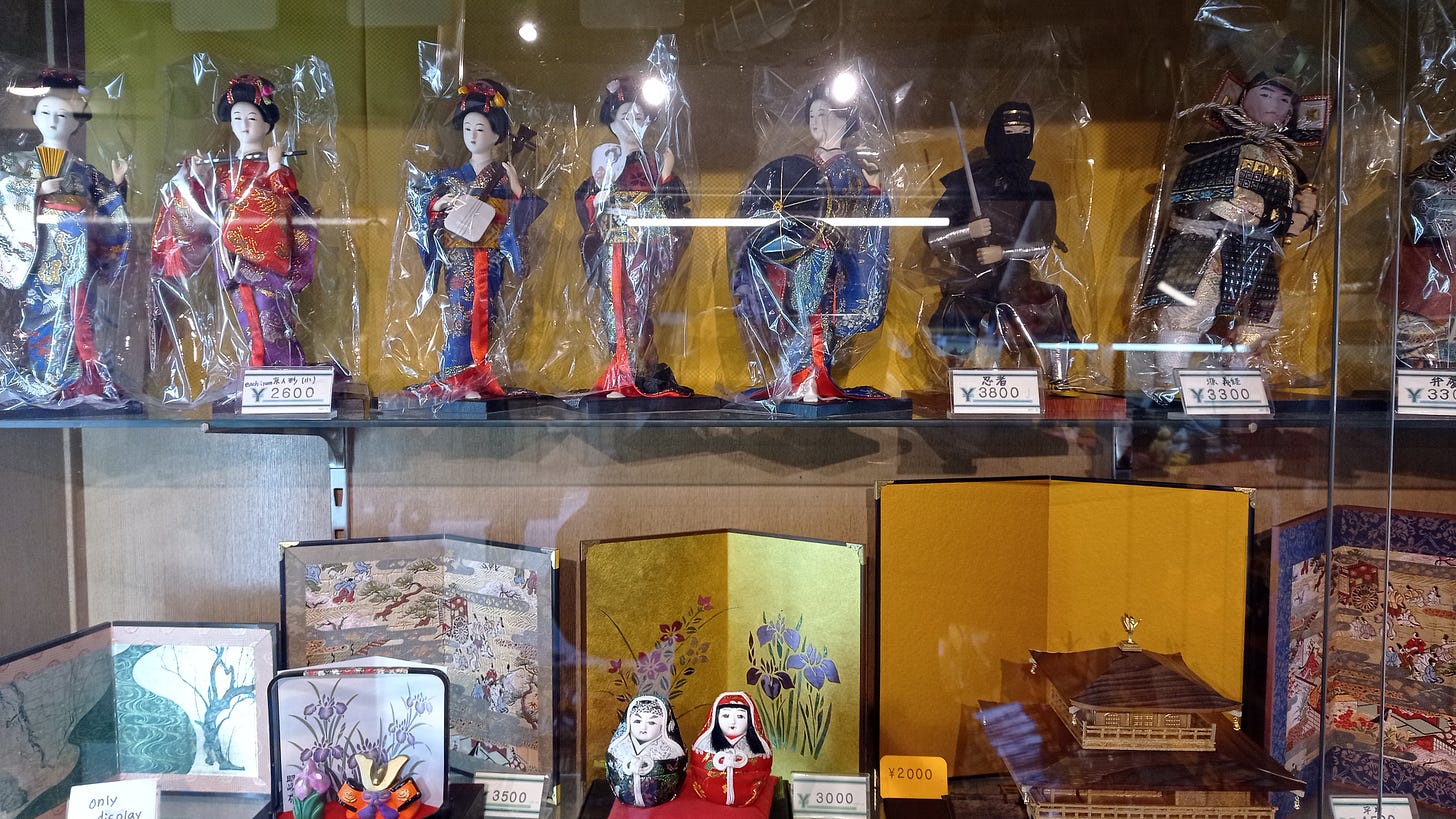

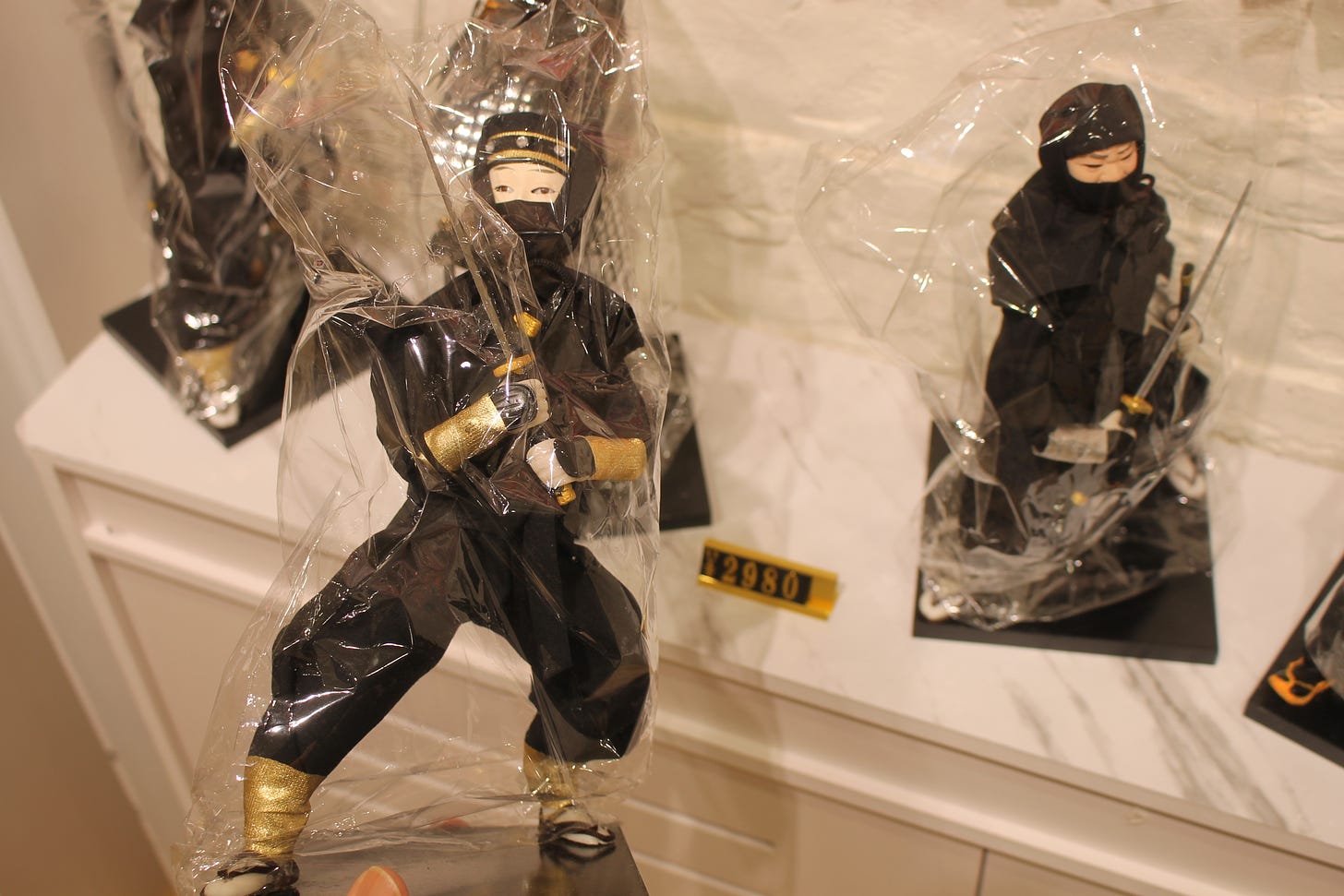
Aside from high quality knives and garden shears, two potentially useful gift or souvenir ideas are:
While walking up the touristy pedestrian shopping street to the Kiyomizu-dera temple complex (a major tourist attraction in Kyoto), I came upon a stand demonstrating and selling Arita Ceramic Coffee Filters in front of the ASAHI Tou’an Craft Shop (Note: I think the filters can also be bought at Hands department stores):
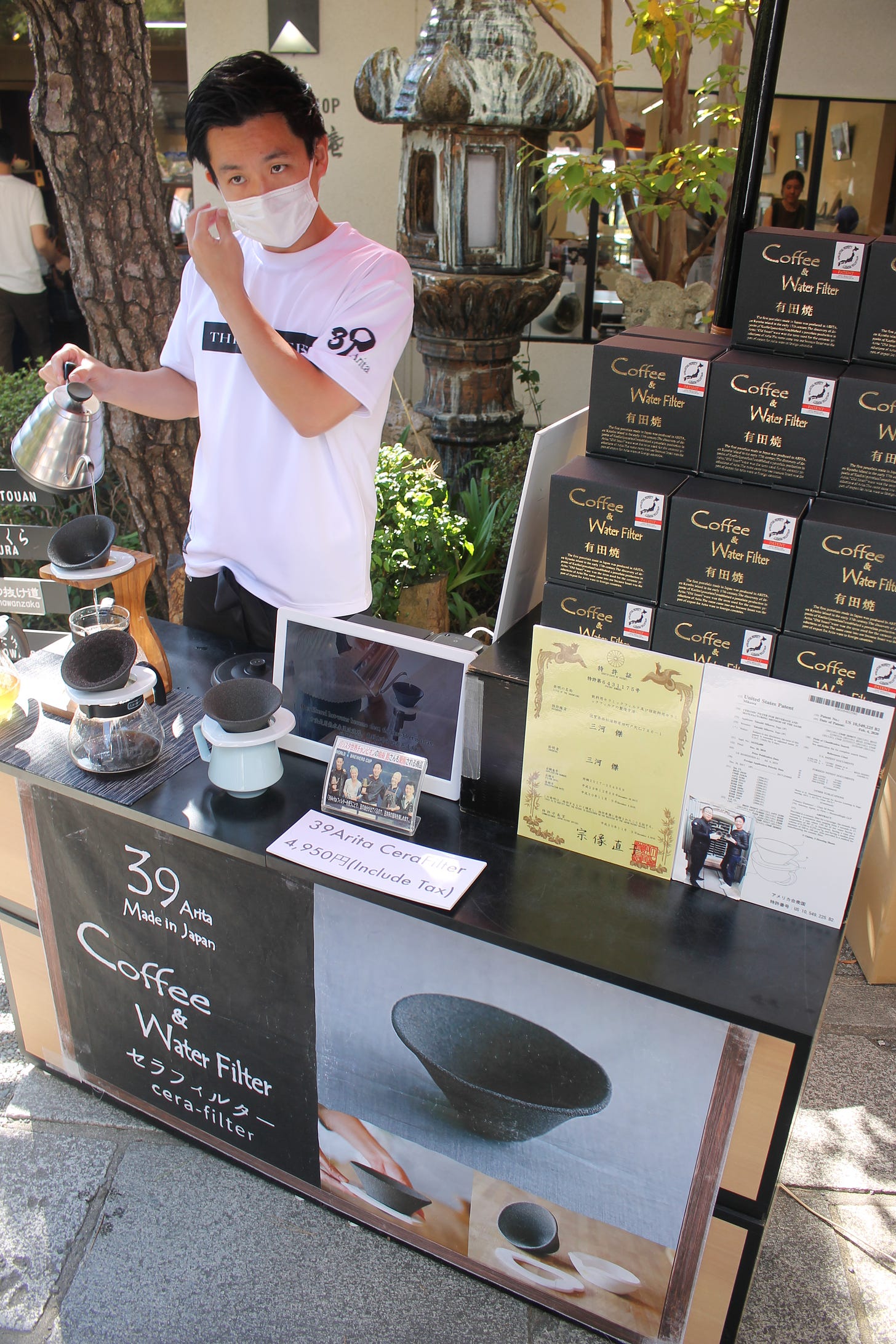

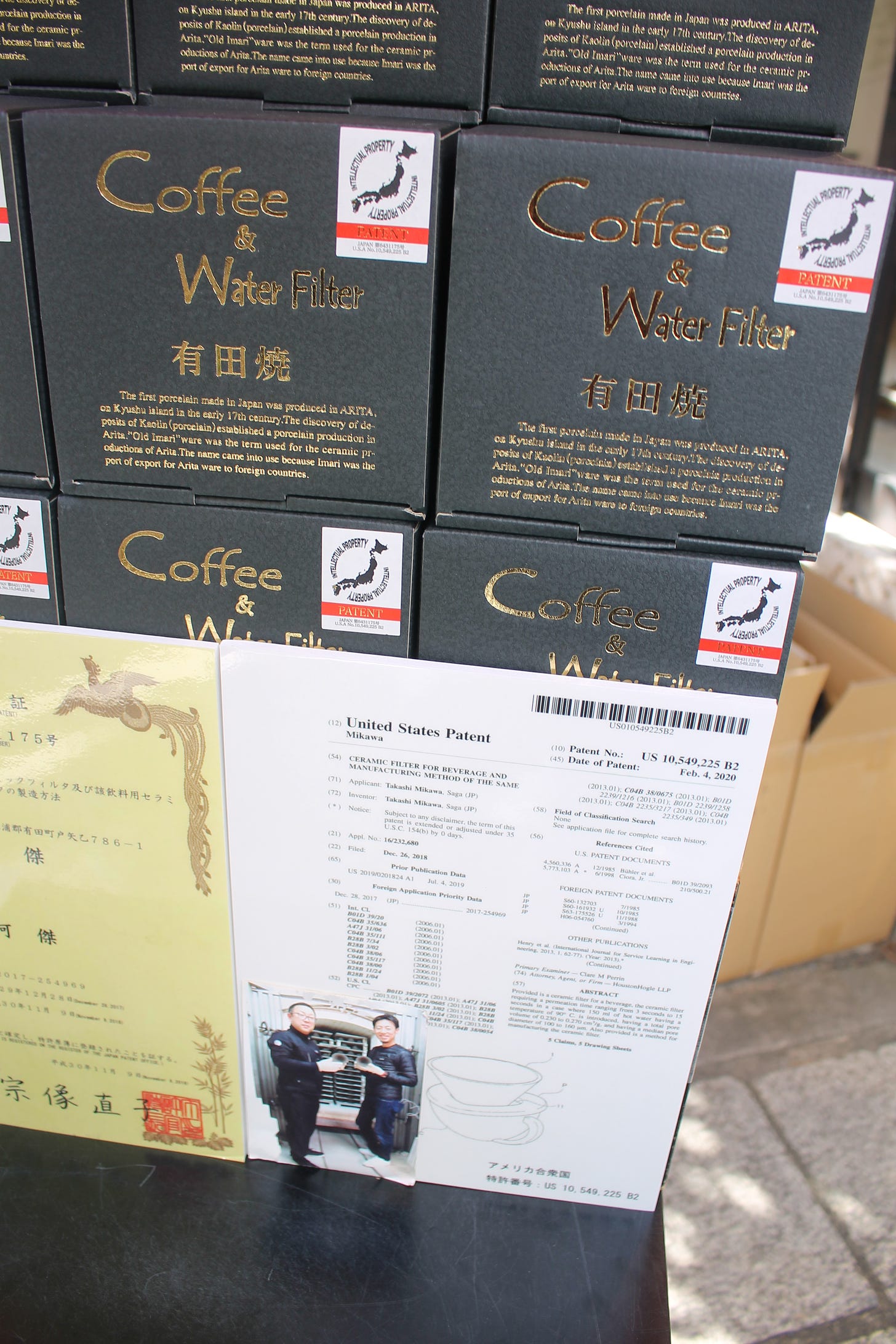
ASAHI Tou’an Craft Shop
朝日堂 クラフトショップ 朝日陶庵店
https://www.asahizaka.kyoto/en//asahizaka_intro/toan/
287-1 Kiyomizu, Higashiyama Ward, Kyoto, 605-0862, Japan

I was intrigued and saw people (other Americans…) buying them on impulse on the spot. Although they were only ¥4,950 or around US$33 (at ¥150 to US$1), I wanted to check online reviews to see what people had to say about them before buying (and having to lug it around and risk having it crack or break).
However, many online reviews were critical:
Japanese Ceramic Coffee Filter Dripper, Reusable, Arita Porcelain
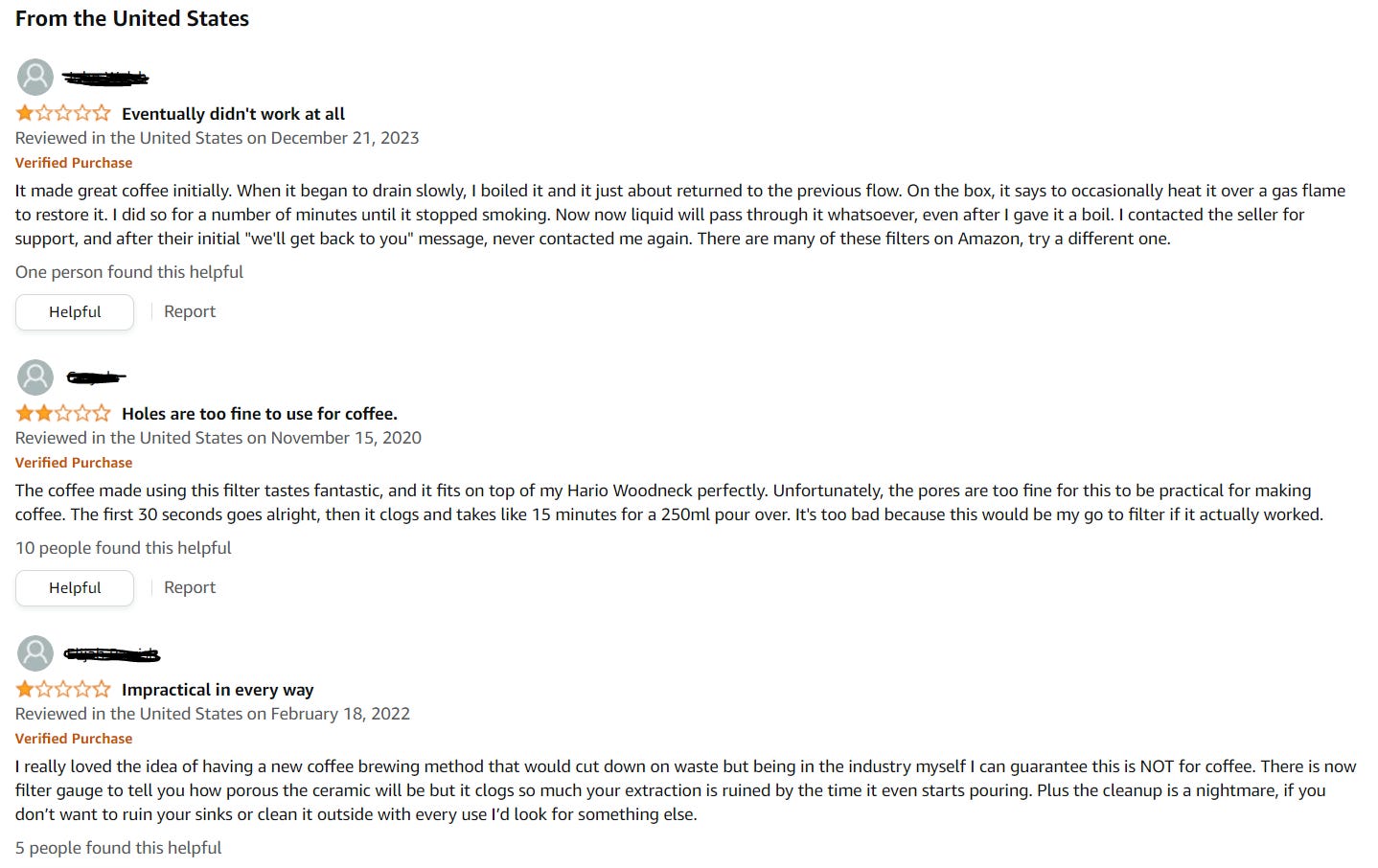
Knowing the accuracy of online reviews from impulse shoppers who probably don’t bother to read the fine print or ask pertinent questions when making a purchase, I mentioned the bad reviews to my dad (as I normally just buy and use coffee in 3 in 1 sachets).
I had no idea that my dad was going to the supermarket in town, picking beans, and then having them ground there (or that the supermarket in my rural hometown was even selling “fancy” coffee like this). He indicated that grinding the beans too fine would clog or slow the flow from the machine he was using. So he has them ground as coarse or medium.
On my last day in Kyoto just before the shop closed, I went back to ask what sort of coffee ground consistency to use since people were complaining online about the filters clogging. He indicated MEDIUM.
This is the consistency of the coffee grounds he had on display:

When I visited my parents over the holidays, I used the Arita ceramic filter once a day for a coffee (with sweetened condensed milk in the cup) after eating lunch plus my dad would sometimes use it (he noticed a difference in taste when drinking it straight compared to using a machine).
However, the filter worked great for roughly a month before dramatically slowing down. By the time I left though, it was very slow and in need of being held over a flame or being placed in boiling water.
The other drawback was cleaning the filter after making a cup of coffee. I had lived in Vietnam and before switching to 3 in 1 coffee sachets, I would use the Vietnamese style metal coffee filters and add sweetened condensed milk / creamer to the cup (even the cheapest of coffees will taste good if you add that!). These filters can also be a pain to clean the coffee grounds from.
My parents do have a Keurig that mainly gets used when certain relatives visit plus I would use the leftover K-Cup pods. While these machines come with easy clean-up, the K-Cup pods are getting more expensive (like everything else in the USA) and they, along with the machine, take up counter space. Also, even these machines will clog (e.g. alkaline, etc. will build up inside and the water will stop flowing…) and you can’t effectively control coffee strength or taste.
To clean, I had to take the Arita ceramic filter to our utility room to wash over a container that could then be dumped anywhere outside as my parents live in a rural area (plus coffee grounds are supposedly good for some plants as well…).
IF you live in a high-rise condo in a city, I don’t think an Arita ceramic filter is going to be a practical option given the grounds need to be washed out after every cup (unless you wash it over a disposable container and eventually throw that out) as you are not going to want to clog your drains. I am also not sure how effective burning the filter or placing it in boiling water will be to clean the clogs since I left it at my parents’ place where its probably not going to be used until my next visit. 🙂
Needless to say, an Arita ceramic filter does make good coffee, but it may not be the most practical purchase for everyone given the cleaning aspect.
I have seen Iwachu cast iron kettles (and other types of kettles) at Isetan department stores in Malaysia and they are not cheap:
My parents also have a freestanding wood burning store they leave a kettle on in winter. So I was thinking that an Iwachu kettle might look good on it (albeit Iwachu kettles are small). Likewise, I could always try to make tea with it as apparently tea boiled in a kettle tastes better (and they come with a filter for tea leaves or a bag).
However, department stores in Japan had a surprisingly limited selection of Iwachu kettles plus the sales clerks seemed to have a limited command of English:

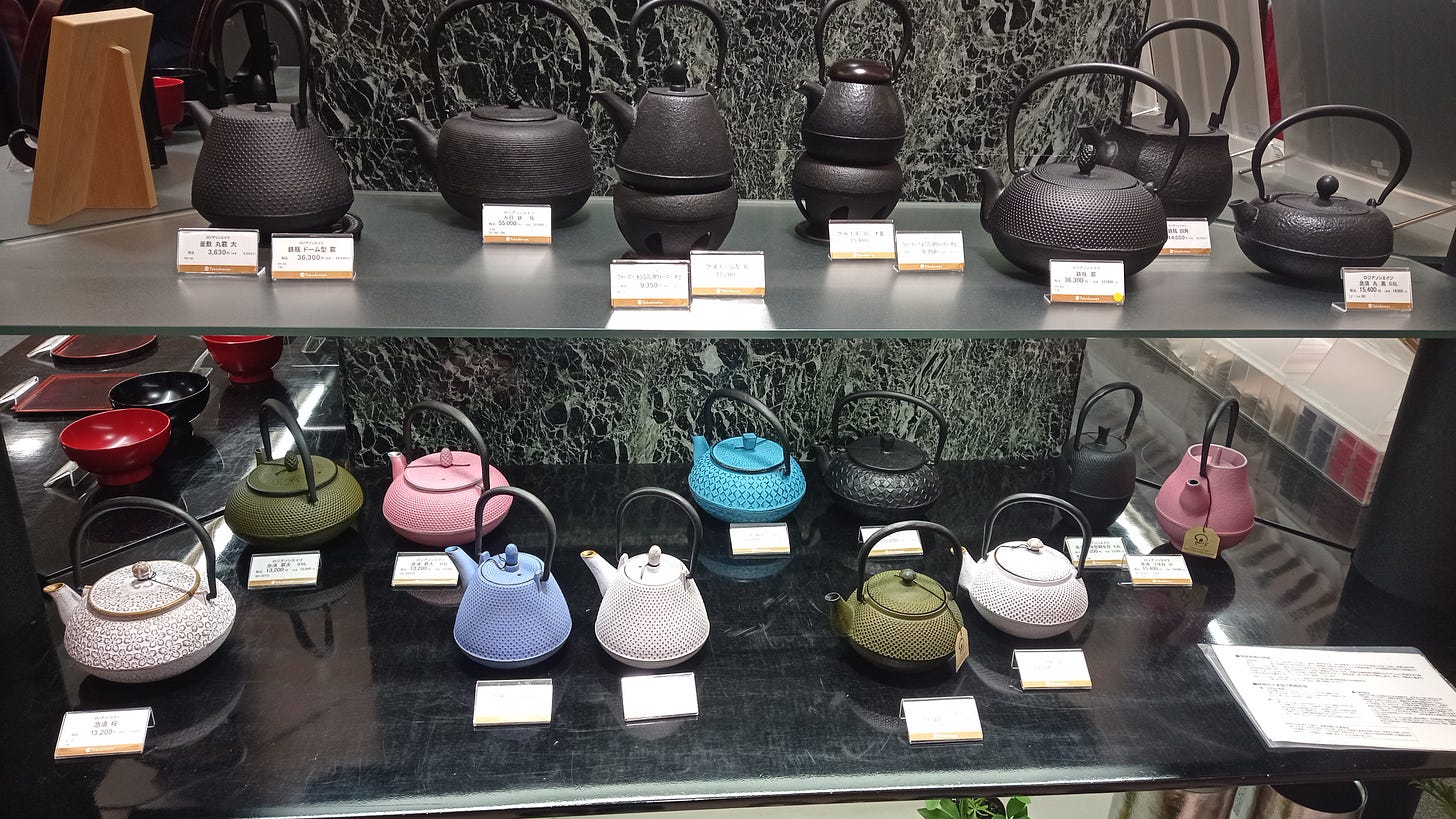
While walking to the popular Inari shrine (with the painted red arch lined pathways), I came across this small tea shop where they had Iwachu kettles displayed in the window:
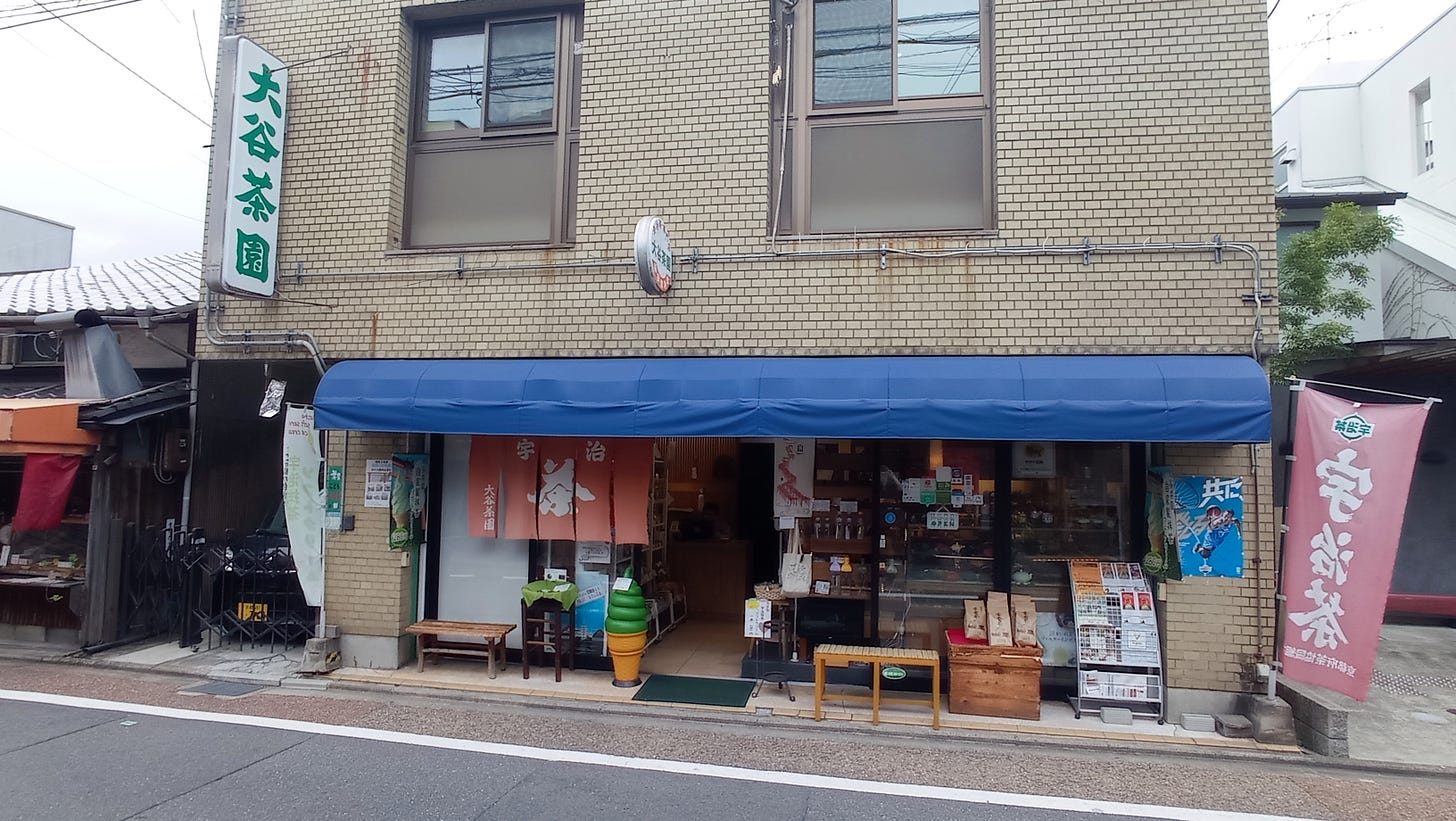
宇治茶の大谷茶園
大谷茶園
29 Fukakusa Inarienokibashicho, Fushimi Ward, Kyoto, 612-0808, Japan
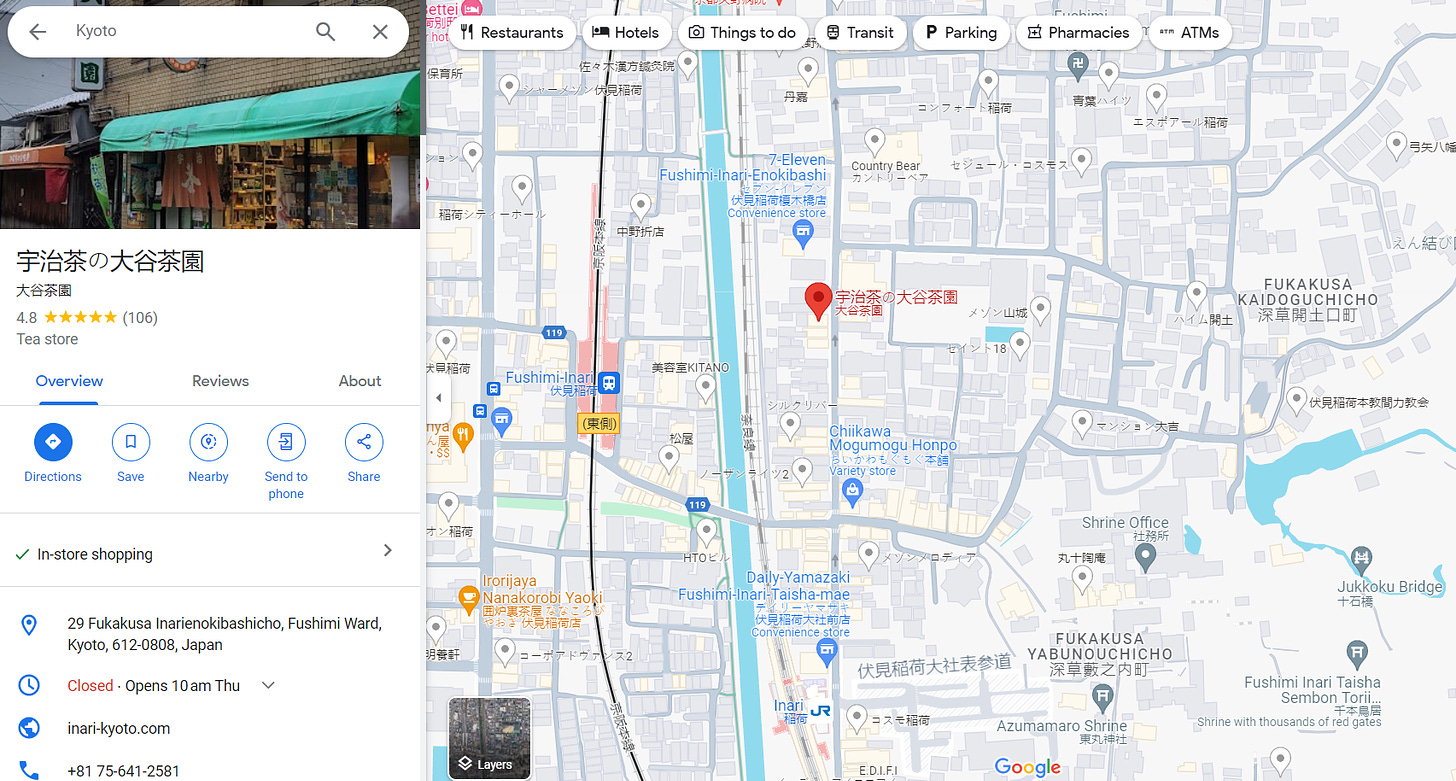
Apparently, the tea shop is 114 years old and one of the shopkeepers could speak good English. They also had a much better selection of Iwachu kettles than the department stores I had gone to:
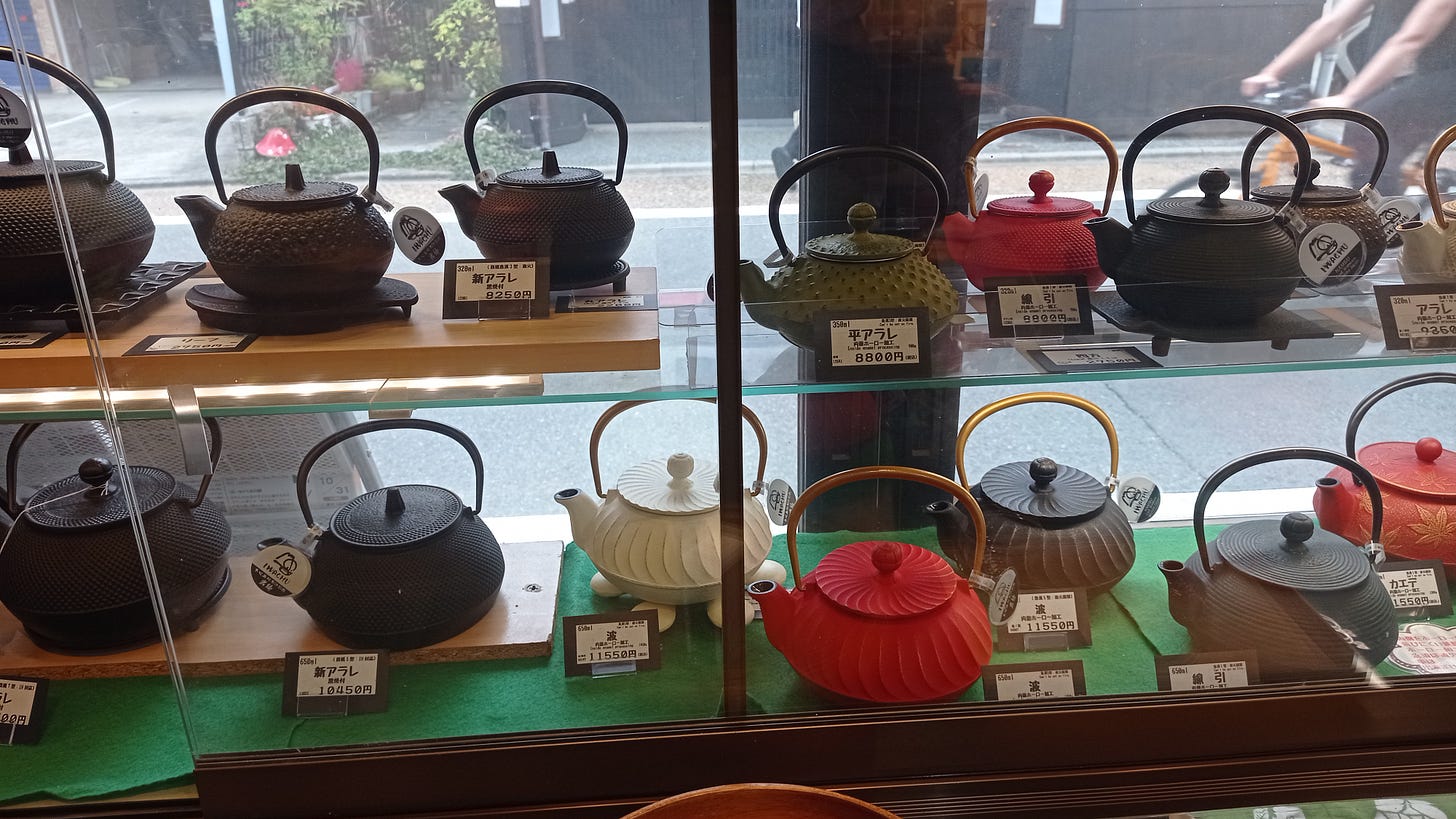
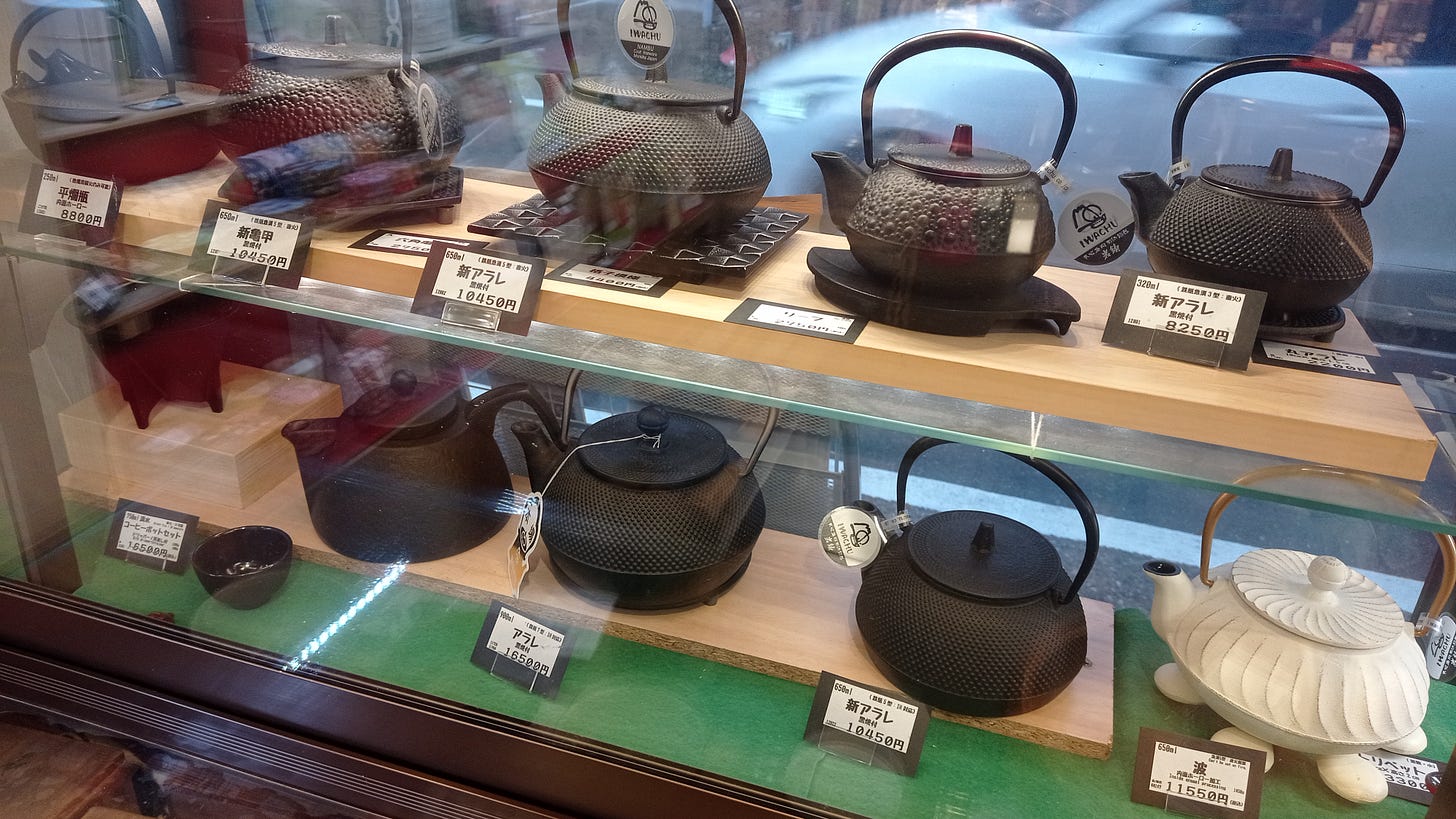
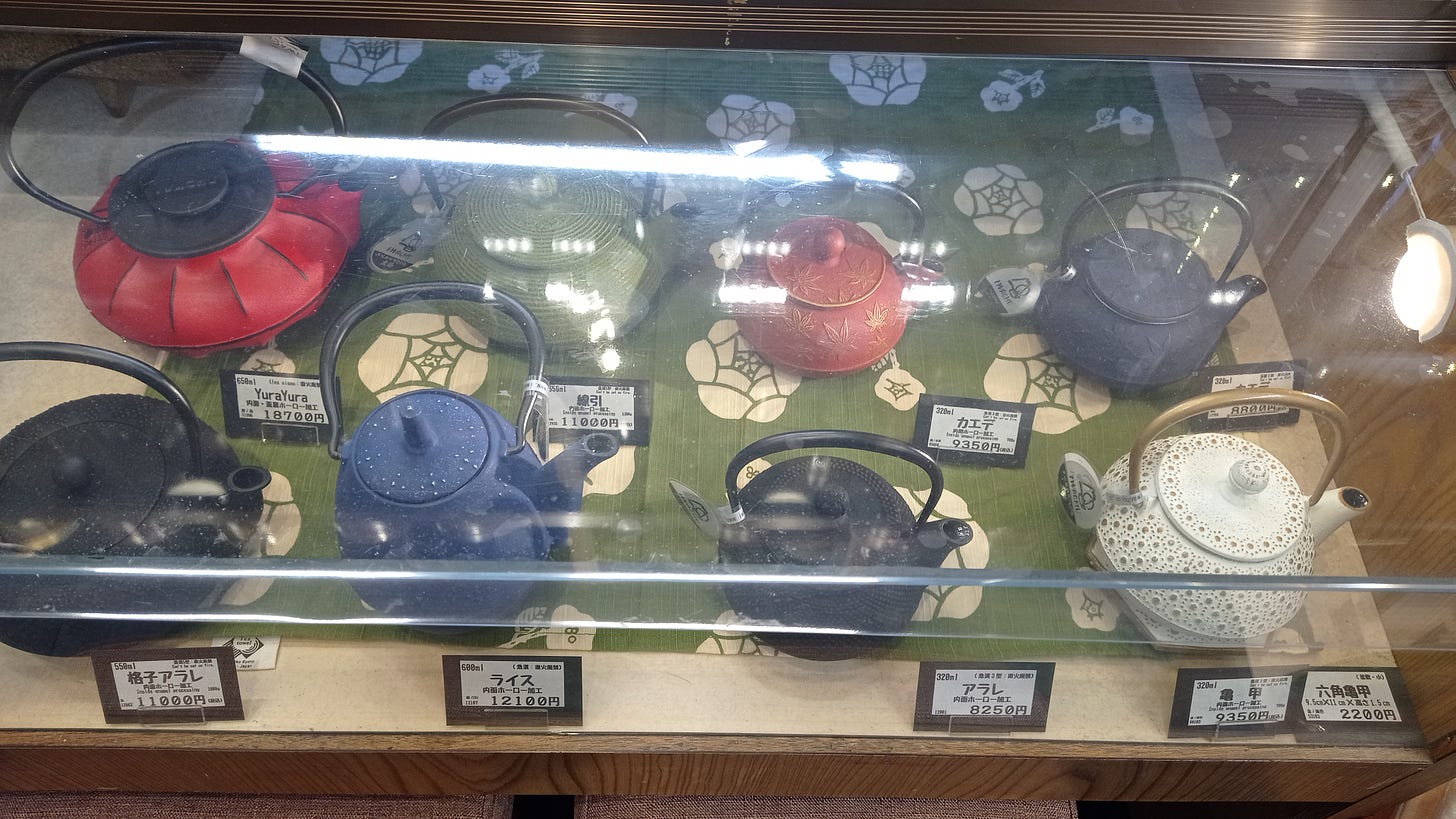
More importantly, the shopkeeper was able to explain to me in English that the coloured pots and those with enamel inside could not be left on hot stoves as the heat would damage them. It was also explained to me that leaving water in the kettle will cause alkaline, rust or something to build up on the surface inside, but this is harmless.
I ended up buying a small black kettle (with no enamel inside) along with a stand (maybe on a future trip, I would buy a coloured one solely to be displayed on a shelf):

Again, there is still a place (at least in Japan) for small shops selling high quality goods with and personal expert service…
Paid subscribers can click here for a post listing recent research pieces and resources for anyone thinking of investing in Japan or Japanese stocks.
Paid subscribers can click here for a post covering some Japanese stocks you might encounter on a trip to Japan.
Disclaimer. The information and views contained on this website and newsletter is provided for informational purposes only and does not constitute investment advice and/or a recommendation. Your use of any content is entirely at your own risk and it is your sole responsibility to evaluate the accuracy, completeness and usefulness of the content. Seek a duly licensed professional for any investment advice. I may have positions in the investments covered. This is not a recommendation to buy or sell any investment mentioned.
Japan Trip Report (Plus Japanese Stocks) was also published on our website under the Newsletter & EMS Analysis categories.

